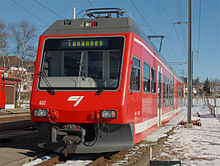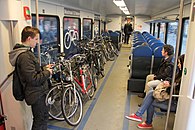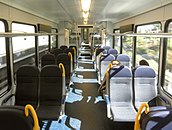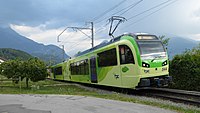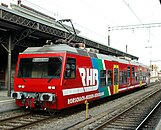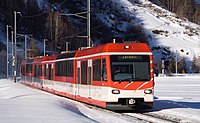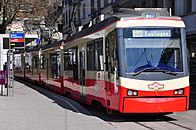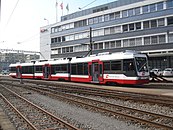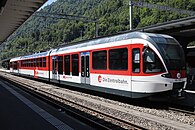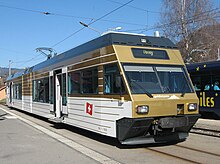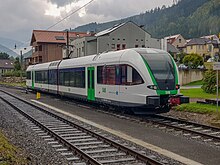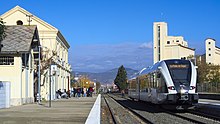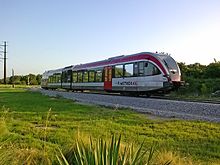Stadler GTW
| Stadler GTW | |
|---|---|
|
Two-part diesel-electric GTW 10257 from Arriva
|
|
| Number: | 605 sold, Dec. 2018 |
| Manufacturer: | Stadler Rail |
| Year of construction (s): | 1995-2017 |
| Axis formula : |
GTW 2/6: 2'Bo2 ' GTW 2/8: 2'2'Bo2' and others |
| Gauge : | 1435 mm , 1000 mm and 1668 mm |
| Length: |
GTW 2/6: 30.1 - 40.9 m GTW 2/8: 53.4 - 55.9 m |
| Width: | 2600 - 3000 mm |
| Fixed wheelbase: | 1600 - 2100 mm |
| Service mass: |
GTW 2/6: 37 - 73.3 t GTW 2/8: 78.5 - 93 t |
| Top speed: |
Standard gauge: up to 140 km / h Meter gauge: up to 100 km / h |
| Short term output: | per traction module 400 - 1200 kW |
| Starting tractive effort: | per traction module adhesion: 55 - 80 kN |
| Driving wheel diameter: | 750 - 870 mm (new) |
| Impeller diameter: | 660 - 750 mm (new) |
| Drive: | electric or diesel-electric |
| Control: | up to four vehicles in multiple traction |
| Seats: |
GTW 2/6: 76 - 134 GTW 2/8: 139 - 192 |
| Standing room: |
GTW 2/6: 65 - 158 GTW 2/8: 139 - 179 |
| Floor height: |
Low-floor area 370 - 830 mm |
| Low floor: | > 65% |
| see also overview of variants | |
The GTW (for G élénk t rubbed w recite ) the company Stadler Rail is a trainset for the rail transport . The most striking feature of all vehicles is the two-axle drive module, which is integrated into the fixed train composition as an intermediate car and contains the complete electric or diesel-electric drive equipment. The GTW 2/6 with diesel-electric drive are operated by Deutsche Bahn as the 646 series .
The vehicle family has a modular structure and its size and equipment can be adapted to the requirements of the respective transport networks. Stadler has been selling the Stadler WINK as the successor model since 2017 , because the GTW can no longer fully comply with the more stringent crash regulations during the construction period.
history
The names of the railway companies are linked to the corresponding section in the Customers and Operators chapter .
First generation
Electric meter gauge GTW of the BTI and CEV


The initiative to develop the articulated multiple unit GTW 2/6 came from the Biel-Täuffelen-Ins-Bahn (BTI) and the Chemins de fer électriques Veveysans (CEV). The two Swiss meter-gauge railways wanted to procure new vehicles, but the vehicle concept initially offered by Ateliers de constructions mécaniques de Vevey (ACMV) and Schindler Waggon was beyond the financial framework of the two railway companies. The specification called for inexpensive and lightweight vehicles with at least 60 percent low-floor space . Traction equipment on the roof should be avoided in order to avoid converting the existing workshops. Stadler then developed a multiple unit in which the drive elements were combined in a two-axle drive module. A forklift truck is sufficient to remove and install the components in the drive module . To save energy and keep operating costs low, in cooperation with Alusuisse of based Kofferkuliwagen the Visp-Zermatt-Brig (BVZ) developed a slight possible car body with screwed side walls. The principle of Stadler's modular vehicle development can easily be seen in these vehicles. They are basically the same, but every customer has their own special features, e.g. B. with regard to vehicle length, driver's cabs or coupling device. In 1997/98 the Be 2/6 501–507 of the BTI and the Be 2/6 7001–7004 of the CEV were put into operation.
Diesel-electric GTW
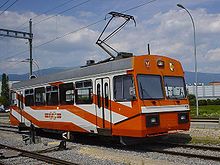
In 1990 Stadler delivered the two-axle Be 2/2 14 electric multiple unit to the standard gauge Orbe-Chavornay Railway (OC). The vehicle aroused interest in Germany, where successors were sought for the two-axle diesel-powered rail buses . As part of a consortium with Alusuisse , SLM , AEG and DWA Bautzen , Stadler took on the lead for the development of the GTW 2/6 diesel multiple unit. The concept of the diesel-electric GTW largely corresponds to the electric one. In addition, the car bodies of the meter- gauge GTW were designed from the start for the higher axle loads of the standard gauge and did not have to be fundamentally redesigned for the diesel GTW.
In autumn 1995 the prototype was presented in standard gauge in Leipzig , in April 1996 test drives were undertaken on the Mittelthurgau Railway (MThB) in Switzerland and in May / June demonstration drives in Austria, Slovenia and the Czech Republic. Despite resistance from the German Federal Railway Authority , MThB was able to use the prototype together with two re-ordered diesel multiple units on the German branch line Radolfzell – Stockach from September 8, 1996 . The consortium was initially unsuccessful in the DB tender.
Electric standard gauge GTW


When the Mittelthurgau Railway (MThB) won the tender for the Schaffhausen – Romanshorn lake line , it ordered ten electric GTW RABe 2/6 units for 15,000 volts alternating current in autumn 1996 . The multiple units should be the same size as a two-part NPZ composition, but only half as heavy and, as the most important criterion, only half as expensive. In addition, cross-border deployment in Switzerland and Germany was required. The inexpensive vehicles are designed for a service life of 25 years. Vehicles used to reach an age of 40 and more - with an expensive modernization in the middle of their useful life. From November 1998 the first two trains were in regular service. The angular vehicles were given the nickname "flower boxes". From autumn 1999, the MThB started operating control cars that matched the GTW , because the number of passengers was constantly increasing.

The Linz Local Railway (LILO) procured eight and six GTWs in two series, which largely correspond to the trains of MThB. However, you have a dual-system equipment for 750 V DC and 15 kV AC voltage to the connection via the stretch of ÖBB to Linz train station to allow. The first eight trains have been in operation since 2000, the second series followed in 2005.
Further developments
After the Hessische Landesbahn (HLB) had ordered thirty railcars, DB Regio 14 also ordered in 1999 and another 30 in the following year. This was followed by the DB subsidiary Usedomer Bäderbahn with 14 and later 9 units. These German orders were handled by the consortium partners AEG and DWA Bautzen. These vehicles had front panels made of glass fiber reinforced plastic . They allow a more lively design, but are tied to certain box widths, because new molds would cause considerable additional costs.
Second generation



After the SLM had announced the development of its own low-cost railcar in 1996, Stadler terminated the cooperation and the chassis were obtained from Fiat - SIG . At the same time, the concept of the three-part GTW was presented.
The meter-gauge GTW for the Tatra Railway in Slovakia, the Chemins de fer du Jura (CJ) and the Chemin de fer Yverdon-Ste-Croix (YSteC) in western Switzerland form a series of 20 vehicles. The middle section of the YStC, operated with 15,000 volts at 16.7 Hz, is based on the standard-gauge GTW of the Mittelthurgau Railway , the direct current version of the other two railways is based on the meter gauge vehicles of the Biel-Täuffelen-Ins-Bahn (BTI) . The GTW for Slovakia received a frontal front like the BTI railcars, while the GTW destined for Switzerland got a new, less angular front.
In the Seetalbahn , which was designed in sections as a standard-gauge tram , guardrails were installed between the road and the railroad track in order to improve the safety of road traffic. Since then, only vehicles with a width of 2.65 instead of the usual 3.00 meters have been able to run, and the SBB procured 17 RABe 520 narrow multiple units, which were designed for the first time as three-part GTWs. Although the narrow railcars are also used on routes with a normal profile , the box strength is only 1200 kN instead of the 1500 kN that is usual for normal-gauge vehicles. The narrow seating because of the narrow clearance profile is not particularly attractive for first- class travelers . The driver's cab made of glass fiber reinforced plastic (GRP), which was installed for the first time for the narrow Seetal GTW , was used in almost all Stadler vehicles and developed into a recognition and trademark of the Swiss manufacturer. So that the RABe 520 can keep to the timetable despite the 37 ‰ gradient of the Seetalbahn and the third passenger module, they were given a gear ratio with a higher tractive effort and a reduced top speed. In addition, newly developed bogies are used that were built by Stadler itself. Two air springs arranged in the middle of the bogie serve as secondary suspension , absorb the turning movements when the track is curved and can also take over the emergency running suspension when operating without air.
The Seetal GTW were the last order that Stadler carried out together with Adtranz . Stadler was able to sell 246 GTWs of the first and second generation. After the sale of Adtranz to Bombardier in 2000, Stadler Rail assumed sole responsibility for the construction of the GTW. The restructuring of the industry led to disadvantages for the railway companies, as almost all contact persons changed.
Third generation





In order to become more independent from competitors, Stadler dissolved the previous cooperation with the railway manufacturer Adtranz and has since been purchasing traction and control technology from ABB . The three-part GTW ordered by Regionalverkehr Mittelland and Thurbo also required an increase to 800 kW continuous output for the electrical central part, for which ABB developed new high-performance traction converters . The deep compared to previous converters intermediate circuit voltage of 740 volts leads to lower switching losses and a reduction in energy consumption. Two independent drive trains prevent a total failure of the vehicle in the event of a malfunction. In order for Thurbo to be able to use their GTW across borders to Germany, they received not only the Swiss but also a German approval .
The South Tyrolean Transport Structures (STA) were the first to receive third-generation diesel GTWs, which are equipped with two diesel engines with an output of 380 kW instead of the previously only 550 kW engine. The advantages of this concept are better acceleration, a top speed increased from 120 to 140 km / h and, due to the double drive train, higher availability. Asynchronous generators were used in series for the first time in a traction vehicle . Compared to the previously common synchronous generators , they are more compact, significantly lighter and cheaper. In accordance with Italian regulations, the South Tyrolean GTW were equipped with a driver's cab for two-man occupation and with materials that would not release any gases harmful to humans in the event of a fire. This contradicts the DIN standard common in Central Europe , according to which flammable materials must be self-extinguishing. In the event of a fire, they release gases that suffocate the fire. The STA diesel multiple units have been running on the topographically demanding Vinschgau Railway since 2004 . With the approval of the GTW in Italy, smaller railway companies received an alternative to the three-part Alstom Minuetto , which brought Stadler further orders from the Sistemi Territoriali railway company . Their four-part GTW consist of two half-trains GTW 2/6, each running in double traction , each with only one driver's cab.
Two vehicles based on the second-generation meter-gauge GTW were delivered to the SNCF in 2004 for their Ligne de Cerdagne . The up to 60 ‰ steep ramps of the meter-gauge route, also known as the “Pyrenean metro”, are negotiated without a gearwheel. The railcars are constructed similarly to the rack-and-pinion GTW of the Montserrat Railway on the Catalan side of the Pyrenees, but shorter. The traction voltage of 850 V DC is fed in via busbars coated from above , which led to adjustments to the bogie and the underframe area.
The third generation innovation is the clever combination of existing assemblies. The use of high-volume components is inexpensive and improves the availability of spare parts. The chassis correspond to the Seetal GTW . The dimensions of the car bodies of the passenger modules have been optimized and the GRP driver's cabs have been enlarged and simplified in terms of production technology, which leads to a slightly more rounded appearance.
Fourth generation
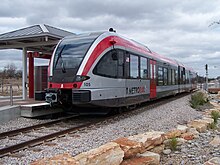
In 2005, Arriva ordered 43 two- and three-part diesel GTWs to serve the Dutch provinces of Friesland and Groningen , which had to be built and delivered in just 29 months. Because the more stringent crash standards were already mandatory in the Netherlands at that time , the end car bodies with driver's cab had to be redeveloped. In addition to the compressive strength of 1500 kN, the car body was increased to a failure load of 3000 kN and the energy absorption capacity in a collision from around 900 kJ to 2100 kJ. The front structure and the side walls of the car bodies were unified with the Flirt car bodies , whereby an integral , complete welded construction with aluminum extruded profiles has been used since then . A higher stability of the shell structure is achieved in this way. In order to simplify the approvals , most of the safety-relevant functions are implemented using relay technology.
In 2007/08 Veolia Transport Netherlands also received two- and three-part diesel GTWs, which largely correspond to those of Arriva. After delivering the diesel GTW to Arriva and Veolia, both companies also won tenders for routes electrified with 1500 volts DC . The GTW supplied for this are equipped with converters that were developed on the basis of the 3 kV Flirt converters. Veolia's electric and diesel-powered trains run in mixed multiple traction . For this purpose, all trains are equipped with switches for starting the diesel engine as well as for the main switch and pantograph .
The vehicles delivered in 2010/11 to Graz-Köflacher Bahn , the former Steiermärkische Landesbahnen (STLB) and Trenord are a further development of the vehicles delivered to the Netherlands. They meet the requirements for the disabled-friendly design of rail vehicles ( TSI PRM). STLB's diesel GTWs can run in mixed multiple traction with their electric GTWs. The car bodies of the Diesel GTW were manufactured in the Siedlce branch in Poland.
The narrow-gauge cogwheel GTWs operated by Transports Publics du Chablais (TPC) and Transports Montreux-Vevey-Riviera (MVR) were given fronts that meet the more stringent crash requirements. The first narrow-gauge vehicles from Stadler with such a front section are the narrow-gauge Flirt ABe 4/8 "Diamant" from BDWM .
Drive modules GTW +
In 2013 Stadler Rail built two four-axle traction modules for Metrowagonmash , a Russian manufacturer of metro and diesel vehicles. They drive the prototype of the DP-M (ДП-М) diesel multiple unit series, which consists of two end cars, each of which is connected to the drive module, and three intermediate cars. Thanks to the generous Russian clearance profile, 652 passengers can be seated in the narrow 3 + 3 seating. Metrowagonmash has an option for a further 98 traction modules, but was not able to sell any series DP-M vehicles until 2016. The Russian Railways want to use a larger number of articulated multiple units on up to 70 electrified and diesel-powered routes.
The Cummins diesel engines have an output of 1119 kW. The air-conditioned aisles through the two traction modules are arranged asymmetrically and have a side window. The components are adapted to the requirements of the Russian market.
Follow-up vehicles

| Weight development of standard gauge electric GTW 2/6 and Flirt 2/6 |
 |
| GTW 2/6 from MThB, Thurbo, Arriva and STLB; Flirt between Abellio and ŁKA |
The Stadler GTW have become heavier and heavier over time, because the more stringent crash regulations are taking their toll. While the first electric GTW earlier Mittelthurgaubahn (MThB) from the year 1998 kg content per seat even with a mass of 483, rose to 2010/11 with two dividers of the former Styrian Railways (STLB) the seat weight to 660 kg at. This makes the GTW 2/6 heavier than the two-part Flirt ET 22 by Abellio from 2007 with 639 kg per seat.
The last electric GTWs received Arriva and Connexxion in the Netherlands in 2012 . The railways now prefer flirting. As a diesel or cogwheel vehicle, the tried and tested GTW was able to hold its own in the market for some time. In 2018, Stadler launched the Wink with diesel or dual-power drive to replace the GTW that no longer fully complies with crash regulations.
technical description
The names of the railway companies are linked to the corresponding section in the Customers and Operators chapter .

GTW is a lightweight - vehicle family , not only externally in different front sides of square until the streamlined different and in various combinations and drive options available, but also in various gauges and as rack railway vehicle , with the standard gauge version of a UIC -compliant full rail vehicle is. The basic concept of the GTW is rather unconventional: A central drive module , also known as a drive container , with its two driven axles drives the multiple unit. Two lightly built end modules, each with a bogie and a low-floor entry, are supported on the drive module, which results in a favorable traction weight.
The concept of the GTW results in a very good use of space in the end modules. Apart from above the bogies and at the supported ends, the GTW are low-floor - with more than 65% low-floor. The GTW 2/6 can be expanded into a GTW 2/8 by inserting a middle car , also with just one bogie. Instead of the middle car, however, a further drive module can also be inserted. In the GTW 4/8, a middle section without a drive was hung between the two adjacent modules. If two GTW 2/6 are connected to each other and two driver's cabs are omitted, a GTW 4/12 is created. For operational flexibility, up to four GTWs of the same type can be driven in multiple traction or a drive-less control car similar to an end car with the axle formula 2'2 'can be carried along.

| vehicles | dare | Seats | standing places |
Total | ||
|---|---|---|---|---|---|---|
| 1st Class | 2nd Class | Folding seats | ||||
| GTW 2/6 | 2 | 8th | 100 | 11 | 81 | 202 |
| GTW 2/8 | 3 | 16 | 156 | 14th | 119 | 308 |
| GTW 2/6 + GTW 2/6 | 4th | 16 | 200 | 22nd | 162 | 404 |
| GTW 2/6 + GTW 2/8 | 5 | 24 | 256 | 25th | 200 | 510 |
| GTW 2/8 + GTW 2/8 | 6th | 32 | 312 | 28 | 238 | 616 |
The modular use of short and light articulated multiple units reduces the operating costs in regional traffic on less heavily used routes. The automatic coupling allows the vehicle driver to weaken and strengthen the vehicle circulation; shunting personnel is not required for this. With two- and three-part GTWs, the trains can be adapted exactly to demand. During rush hour , the trains run in multiple traction, otherwise they run in one piece. The stored compositions save energy and track price costs and maintenance and repair work can be carried out on them. The disadvantage of this operational concept is the fact that the fleet is split into two types.
Mechanical part


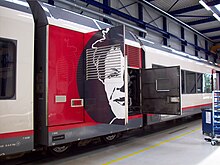



The car bodies for standard gauge vehicles are designed for a static compressive strength of 1500 kN , those for meter gauge for 800 kN. The drive module is a welded steel construction with a stable base frame and large maintenance openings that allow good access for maintenance work. The vertical and horizontal supports of the side walls are bolted to allow large components to be removed.
The car bodies of the low-floor support cars are made entirely of aluminum and up to and including the third generation with a combined screw-welded construction. The box structure is designed for the installation of the UIC coupling as well as automatic central buffer couplings , which enable the formation of wing trains . The door portals, which transfer a large proportion of the forces, are also welded to the welded underframe tray and the longitudinal roof profiles. The other connections of the side walls with the floor pan, the roof and the roof crossbars are screwed, the connection between the sandwich roof and the roof bow is glued. The C-rails required to attach the easy-to-clean cantilever seating are integrated in the external longitudinal belt profiles. The short car bodies allow a larger width than usual and with standard gauge a 2 + 3 seating arrangement that is not very popular with travelers.
The support carriages are supported vertically on the drive module by means of layered rubber springs. The rubber-mounted box support keeps engine noise and vibrations away from the passenger compartment. A trailing arm with rubber spherical bearings transmits the tractive and braking forces. In order to prevent the motor vehicle, which is loaded on both sides by the support car, from pitching , a steering system in the roof above the passage in the drive module keeps the motor vehicle at the bisector of the longitudinal axes of the two semi-mounted support cars. To enable a quick separation of the car parts, all elements of the support joint connection and the closed bellows are combined in an intermediate frame , which can be separated from the drive module with a few screws during the workshop visit .

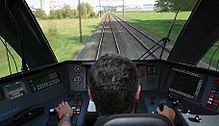
The newly developed trolleys are designed to meet the special requirements of an articulated multiple unit. Both the engine chassis and the running bogies are an evolution of the motor car Be 4/4 of Uetlibergbahn used SLM - steering axle bogies. The radially adjustable wheel sets are suitable for low-wear driving on narrow curves without screeching curves. The central components of the power unit under the short drive module are the two motor-gear units with the transverse motors and the two-stage spur gears . Because there are no deflections in relation to the motor vehicle body, there is no need for a bogie frame, cradle and pivot pin . The vertical loads are transferred from the box to the axle bearings via flexicoil springs . A deep-draw linkage transfers the longitudinal forces and guarantees the maintenance of practically the same drive gear set loads when pulling and braking forces are exerted, which is one of the decisive factors for good utilization of adhesion . The running bogies are designed to be very low in order to keep the floor of the car as low as possible. Its torsion-soft H-shaped bogie frame leads to a high degree of safety against derailment even with poor track conditions .
The mechanical brake is a classic indirect brake with a UIC control valve . The low axle load of the running bogies leads to the problem of the increased tendency to slide when braking, which is typical for light railcars, for example on tracks soiled by foliage, which can not be completely absorbed by the anti-skid regulator . A magnetic rail brake works independently of the static friction of the rails and is triggered when the main air line pressure is below 3 bar . Leaf fall led to problems at Veolia Netherlands in autumn 2010 because the track circuits no longer recorded the light passenger modules in some cases, which meant that the railway barriers remained open and signals indicating the journey did not fall back on the train after the train had passed.
The articulated multiple units can be equipped with all the comfort features expected of modern local trains:
Air conditioning on the roof of a GTW from Thurbo
Laden with bicycles multipurpose room ( Arriva , Netherlands)
Handicapped accessible vacuum toilet , Arriva
Generous windows that allow an unobstructed view of the landscape, Ferrovie Nord Milano
Electrical equipment
The electrical equipment of the GTW is composed of a IGBT - converter of ABB , and two asynchronous traction motors , wherein the auxiliaries are incorporated in the main inverter. Collector traction motors with conventional driving and braking circuits were only used in the first version of the MThB Bm 596 with diesel-electric drive . The converter consists of a DC - DC , a four-quadrant controller and a drive converter. In Einphasenwechselstrombetrieb represents the four-quadrant together with an absorption circuit the connection between the overhead line Smains lying transformer and the DC voltage intermediate circuit forth. In the case of direct current operation , the four-quadrant controller is not required and the connection to the mains is limited to an input choke coil and a high-frequency filter . With diesel-electric drives , the four-quadrant converter is replaced by the output rectifier of the diesel generator . The drive converter generates the frequency and voltage-variable three - phase alternating current for the traction motors from the DC link voltage . The converters are able to return the braking energy released by the traction motors to the network in recuperation braking mode. In the case of diesel-electric drives or if the overhead line network cannot absorb the braking energy, the braking resistors of the resistance brakes convert the braking energy supplied by the traction motors into heat. The electric brake is used as much as possible, the missing braking force is automatically supplemented by the disc brake via the EP controller . Up to four vehicles can run in multiple traction; it is also possible with flirtation .
Drive with diesel engines

The first-generation diesel -powered GTWs were equipped with a twelve-cylinder V- engine of the type 83-TD13 from MTU Friedrichshafen with a nominal output of 550 kW . Because of the width of the twelve-cylinder engine, the passage through the drive module had to be arranged asymmetrically. The very compact structure of the drive module sometimes causes insufficient cooling of the machine system on hot summer days, so that the power is automatically limited and the required mileage is not achieved.
In the second generation, two high-speed, water-cooled six-cylinder in- line truck engines , each with a rated output of 390 kW, were installed by MAN , which meet the strict Euro 3 emissions regulations for road traffic. The procurement of truck engines produced in large quantities is also more cost-effective than special diesel engines for rail vehicles. The two drive units, which are now completely separate, have a higher output than the MTU engine and the advantage of redundancy , so that one unit can continue to operate in the event of a fault. The two diesel engines are arranged on both sides of the drive module and allow symmetrical passage from one passenger compartment to the other. The vehicles procured for Arriva Gelderland and Connexxion in 2012 received newly developed Deutz TCD 16.0 V8 diesel engines. The water-cooled eight-cylinder engine with 350 to 520 kW meets the emissions standard IIIB (Tier 4 interim) and generates a maximum torque of 2890 Nm at a speed of 1400 rpm .
Gear drive

After the Swiss Lokomotiv- und Maschinenfabrik (SLM) was dissolved in 1988, Stadler Rail was able to take over its cog railway division. As the first GTW with gear drive , Stadler delivered five vehicles to Ferrocarrils de la Generalitat de Catalunya (FGC) for the Montserrat Railway in 2003 .
The two axes of the drive module are equipped with a combined gear and adhesion drive . The short gear ratio enables the 150 ‰ ramps to be driven on with just two drive gears, but limits the maximum speed in adhesion mode to 45 km / h. The two drive bogies with the gear drive and the detachable adhesion drive were derived from the Beh 4/8 from Transports Publics du Chablais (TPC). The running bogies with braking gear for the geared GTW of the Montserrat Railway and the Zermatt Shuttle BDSeh 4/8 of the Matterhorn-Gotthard Railway (MGB) were newly developed as the basic bogie. Gear brakes, which act on both drive gears and on one axle each of the two running bogies, allow a speed of 24 instead of the previous 19 km / h on the rack sections when going downhill. For weight reasons, specially light seats were installed and, compared to the narrow-gauge GTW of the first of the second generation, a new longitudinal member profile was produced, which was also used in the MGB Zermatt shuttle that was built at the same time. Despite air conditioning and modern interiors, a rack-and-pinion GTW on the Montserrat Railway cost only 60% of a rack- and-pinion double multiple unit for the Ribes – Núria line supplied ten years earlier by ABB and SLM to the same customer .
The FCG received two vehicles of the same type as the Montserrat Railway in 2013 for the Ribes – Núria route . In contrast to the green vehicles on the Montserrat Railway, they are painted blue.
In 2012, Stadler supplied four GTWs for the rack railway on the Puy de Dôme , based on those of the Montserrat railway. They have an unconventionally designed forehead with a large window.
The standardization of the overhead line voltage to 1500 volts prompted Transports Publics du Chablais (TPC) to procure seven cogwheel GTWs for the Aigle – Ollon – Monthey – Champéry route.
The cogwheel GTW of Transports Montreux – Vevey – Riviera (MVR) correspond to the GTW of TPC and have more capacity than the previous adhesion GTW. They allow a continuous journey from Vevey to Les Pléiades .
Vehicles derived from the GTW

A specialty of Stadler Rail is the production of special and individual vehicles that are designed and built for a customer. The technical requirements often call for tailor-made vehicles, using existing components as far as possible.
Several small series and one-offs for cogwheel and narrow-gauge railways were derived from the GTW, with the multiple units consistently having more than two drive axles:
The electrical equipment of the articulated cog railcar RHB BDeh 3/6 from 1998 largely corresponds to that of the GTW.
When the first generation GTW reached its capacity limit, it added four matching Bt 221-224 control cars (1999) to the Mittelthurgau Railway.
Meterspuriger Matterhorn Gotthard Bahn Bdseh 4/8 with gear drive. The two low-floor end car bodies are classic GTW constructions (1999).
The Be 4/8 of the Trogenerbahn with powered intermediate cars and car bodies in the design of the GTW were developed together with the Be 4/6 of the FB (2004).
The Stadler Spatz of Brünigbahn and for the route Saint-Gervais-Vallorcine largely correspond to the Matterhorn Gotthard Bahn Bdseh 4/8, but do not have a gear drive (2004).
Also, the construction of low-floor articulated control car from BOB , Central Railway and MGB is derived from the GTW. The box concept comes from the MGB BDSeh 4/8 (2004).
The MGB Komet is derived from the BDSeh 4/8, whereby the length of the passenger modules has been optimized for the largest possible passenger capacity (2007).
The low-floor control cars Bt 55 of the Travys and ABt 51-61 of the AAR Bus + Bahn (picture) correspond in principle to a GTW end car (2007/08).
Customers and operators
Switzerland
Standard gauge
- Thurbo , formerly Mittelthurgaubahn (MThB)
-
- Prototype series; Taken over by SBB GmbH , sold to Ferrovie del Sud Est (FSE) in 2007
→ see also section History / First Generation
- RABe 526 680–689 (1996), GTW 2/6 Seelinie
→ see also section History / First Generation
- Prototype series; Taken over by SBB GmbH , sold to Ferrovie del Sud Est (FSE) in 2007

-
Thurbo (new acquisitions or takeover from SBB)
- RABe 526 701–751 (2003–2005), GTW 2/6 (EVN 94 85 7 526 7xx-x), 720–751 with approval in Germany
- RABe 526 752–780 (2005–2007), GTW 2/8 (EVN 94 85 7 526 7xx-x)
- RABe 526 781-790 (2008, conversion / extension from 526 709-718), GTW 2/8 (EVN 94 85 7 526 7xx-x)
- RABe 526 791–805 (2012–2013), GTW 2/8 (EVN 94 85 7 526 xxx-x)
- RABe 526? (two vehicles, 2003) taken over by SBB
- The SBB subsidiary Thurbo is active in regional transport in Eastern Switzerland. Your vehicle fleet consists exclusively of GTW and four matching control cars.
- When reordering the twelve third generation RABe 526 791–802s in 2010 for the St. Gallen S-Bahn , Thurbo was criticized for procuring vehicles that no longer correspond to the latest technical standards in various respects. A uniform fleet for maintenance and spare parts storage is advantageous. For the operation of the newly electrified Schaffhausen – Erzingen line of the S-Bahn Schaffhausen , Thurbo ordered three more trains with the RABe 526 803–805.
- Two Thurbo GTWs were involved in the Neuhausen railway accident at the Rhine Falls on January 10, 2013 . The badly damaged RABe 526 750 received a new car body.
- To operate the Bülach – Koblenz –Waldshut route, Thurbo buys two Seetal GTWs from the SBB. Despite the takeover, they will continue to be used in the pool with the vehicles remaining at the parent company.
- Names:
701-8 Kanton Thurgau , 702-6 Frauenfeld , 703-4 Kanton St. Gallen , 705-9 Säntis -Express, formerly 706-7 Spieleland -Express (today 720-8 without name), 706-7 (formerly 720 -8) Simone Niggli , 707-5 Top -Blitz, 708-3 Steinach , 722-4 Märwil , 724-0 Conny-Land -Express, 726-5 Rorschach / Rorschacherberg , 727-3 Napoleon III. , 728-1 Läufelfingerli, 729-9 Kanton Aargau , 730-7 Wil , 731-5 Waldshut-Tiengen , 735-6 Rümikon , 742-2 Flawil , 744-8 formerly Säntis-Express, 745-5 Stein am Rhein , 746 -3 Sirnach , 747-1 Elgg , 748-9 Elsau , 749-7 Neunkirch , 750-5 Zürcher Weinland
752-1 Steckborn , 755-4 Rheinfall , 757-0 St. Galler Rheintal , 758-8 Sargans , 760-4 myblueplanet, 761-2 Untersee and Rhein , 767-9 Kreuzlingen , 769-5 Maienfeld , 770-3 Bazenheid , 771-1 Canton Lucerne , 773-7 thurgau-bodensee.ch, 776-0 Insel Mainau , 777-8 Turbenthal , 779-4 Sympany , 780-2 Bussnang , 781-0 Canton Schaffhausen , 782-8 Altstätten , 783-6 Lake Constance , 785-1 Municipality Eschlikon , 786-9 Zurzach , 787-7 Barockes Bischofszell , 788-5 Romanshorn , 789- 3 Aadorf , 790-1 Zihlschlacht-Sitterdorf , 791-9 Spieleland -Express, 792-7 Euregio Bodensee , 794-3 Chur , 795-0 Leila Lawrizy, since 2017 Nick Schär, 800-8 100th Thurbo-GTW - Name: 682-0 Amriswil
-
Swiss Federal Railways (SBB) Seetalbahn
- RABe 520 000-016 (2003), GTW 2/8 ( EVN 94 85 0 520 0xx-x)
- The RABe 520, specially procured for the Seetalbahn Lenzburg – Lucerne, differ from the standard version with their narrow car body, twice the number of doors and the entrance height of just 35 instead of 55 cm, which is adapted to the platform height of the Seetalbahn. However, the narrow envelope space under the narrow car bodies leads to a tough running of the car. The narrow seats in the narrow vehicles and the short seat divider of only 1650 mm in the first class also contribute to the moderate travel comfort. The generous reserve of copies allows the SBB to use the trains off their regular routes.
- By 2020/2021, the RABe 520 will be subjected to a major overhaul after half of their useful life . Are provided u. a. a corrosion treatment of the aluminum vehicles, a repainting and a new passenger information system . In addition, the entrance to one of the two doors in the middle passenger module is increased to 550 mm so that wheelchair users can also get on and off at standard platforms without assistance. For this purpose, the two entrances inside the car are connected by a two-part ramp. At the beginning of November 2018, the first converted and newly painted RABe 520 008 could be observed on test drives between Olten and Sursee.
- → see also section History / Second Generation
- Names:
000-1 Seon , 001-9 Beinwil am See , 002-7 Hochdorf , 003-5 Emmen , 004-3 Mosen , 005-0 Eschenbach , 006-8 Hitzkirch , 007-6 Boniswil , 008-4 City of Lucerne , 009-2 Heidegg Castle , 010-0 Staufen , 011-8 Ballwil , 012-6 Hallwil , 013-4 Lenzburg , 014-2 Gelfingen , 015-9 Ermensee , 016-7 Birrwil
-
BLS AG , formerly Regionalverkehr Mittelland (RM), sold to SBB in 2013 and further to Thurbo in 2018
- RABe 526 260–265 (2003), GTW 2/6, from 2009/10 GTW 2/8
- RABe 526 280–286 (2004), GTW 2/8 (EVN 94 85 0 526 2xx-x)
- The GTWs that had become BLS AG through the merger of the Mittelland regional transport with BLS Lötschbergbahn were a foreign body in the new railway company's fleet. BLS AG had the six two-part trains extended by one module in order to obtain a uniform series. They kept their previous red paintwork, as a buyer was sought as part of the fleet adjustment. The 13 now three-part vehicles were replaced by Nina and sold to SBB in 2013, which required the trains for the Biel – Sonceboz – La Chaux-de-Fonds / Moutier operated with a wing train concept . In 2018, the SBB subsidiary Thurbo took over GTW from the parent company, as it will have to replace the RABe 526 680-689 that has come to an end in a few years. Until then, the trains will be rented back to SBB and overhauled.
- Names:
260-5 Lucerne Hinterland, 261-3 Gotthelf , 262-1 Weissenstein , 263-9 Emme , 264-7 Napf , 265-4 Wankdorf
280-3 Aare , 281-1 Pierre-Pertuis , 282-9 Oberaargau , 283 -7 Willisau
Meter gauge
-
Aare Seeland mobil (ASm), formerly Biel-Täuffelen-Ins-Bahn (BTI)
- Be 2/6 501-507 (1997)
- Be 2/6 509-510 (2007)
- Be 2/6 511–513 (formerly CEV Be 2/6 7001–7003)
→ for the vehicles of BTI and MVR (formerly CEV) see also section History / First Generation
- Since 1997, the Biel – Täuffelen – Ins line has been operated entirely by GTW, which allowed the top speed to be increased from 65 to 80 km / h. The quality improvements led to an annual increase in frequency of 3 to 4%. The second series has been equipped with air conditioning since delivery, the first series was retrofitted.
- After 20 years of service, the vehicles receive a comprehensive refit program with a red repaint like the Be 4/8 . The replica vehicles 509-510 only get a new passenger information system . The trains taken over by MVR will be included in the refit program, adapted to the overhead line voltage of 1300 instead of 900 volts and equipped with air conditioning. The modernization was delayed for at least a year, because the losing party Railmaint against the award rekurrierte . The traction module 508 procured with the first series will not be included in the modernization and will be retired in the medium term.
- Transports Montreux – Vevey – Riviera (MVR), formerly Chemins de fer électriques Veveysans (CEV)
- As of 2011, the vehicles that have meanwhile come to the MVR were given a new coat of paint in the Golden Pass design.
- Names: 7001 Vevey , 7002 St-Légier-La Chiésaz , 7003 Blonay , 7004 Montreux
-
Transports Montreux – Vevey – Riviera (MVR) (new procurement)
- ABeh 2/6 7501–7508 (2015–2017)
→ for the gear GTW of the MVR and the TPC see also section Technical Description / Gear Drive
- ABeh 2/6 7501–7508 (2015–2017)
- The ABeh 2/6 with mixed adhesion and cogwheel operation mainly operate between Vevey and Les Pléiades , where they replace the shorter Be 2/6 with pure adhesion drive and older vehicles on the upper section with a rack. They also run regional trains on the Montreux – Les Avants MOB section .
- Names: 7501 Saint-Légier-La Chiésaz , 7502 Blonay , 7503 Blonay-Chamby , 7504 Vevey
- Trogenerbahn (TB)
- In 1997 the Trogenerbahn wanted to procure two GTWs similar to BTI vehicles , which was rejected by the Federal Office of Transport with regard to the Riethüsli tunnel planned at the time and the possible passage to Teufen . In 2000 two new multiple units could then be put out to tender. The delay made it possible to obtain more suitable Be 4/8 with four instead of two drive axles for the steep stretch of the Trogenerbahn . (see also section vehicles derived from GTW )
-
Travys , formerly Chemin de fer Yverdon – Ste-Croix (YSteC)
- ABe 2/6 2000–2001 (2001)
→ for the vehicles of the YSteC and CJ see also section History / Second Generation
- ABe 2/6 2000–2001 (2001)
-
Chemins de fer du Jura (CJ)
- ABe 2/6 631-634 (2001)
- On December 16, 2012, after a storm, ABe 2/6 631 collided between orange and Tramelan lingerie with a large tree top that had fallen onto the rails. The GTW derailed and drove down a steep stretch of forest. After the demanding recovery, the train was repaired in the RhB workshop in Landquart.
- Names: 631 Pouillerel , 632 Mont Soleil , 633 La Gruère , 634 Le Tabeillon
-
- ABeh 2/6 541-547 (2016)
- As part of the conversion to the uniform overhead line voltage of 1500 volts, the TPC replaced a large part of the fleet with the ABeh 2/6 541-547. The rack-and-pinion GTWs put into service in 2016 operate on the Aigle – Ollon – Monthey – Champéry line , but can also be used on the other meter- gauge lines starting from Aigle .
- Names: 541 Cime de l'Est , 542 La Forteresse, 543 La Cathédrale , 544 L'Éperon , 545 La Dent Jaune , 546 Les Doigts, 547 La Haute Cime
-
Meiringen-Innertkirchen-Bahn (MIB) formerly Chemins de fer électriques Veveysans (CEV)
- Be 2/6 13 (formerly CEV Be 2/6 7004)
- The Be 2/6 for the MIB has been modernized together with the GTW intended for the ASm, but has been given a blue exterior paint job. It replaces the Be 4/4 8 , which the MIB had revised in 2012. However, the electronics remained unchanged at the time and are increasingly proving to be prone to failure.
Germany
-
SBB GmbH , formerly Euro Thurbo Seehäsle
- Bm 596 671-673 (1995), diesel prototypes from 1996, formerly MThB
- The prototype series made negative headlines for a long time until it was extensively renovated in 2005/2006. As before, they were serviced at the SBB depot in Weinfelden , which resulted in expensive empty runs . In 2007 the three Ferrovie del Sud Est (FSE) trains were sold.

-
Hessian State Railway (HLB)
- UIC series 646 400–430 (1999–2001), GTW 2/6 DMU
- 508 101–103 (1999, originally KNE , with toilet, until the end of 2008 only Wabern – Bad Wildungen )
- 509 104–112 (1999, originally BLE , without toilet)
- 508 113–115 (1999, originally BLE, without toilet)
- HLB 119–130 (2000–2001, originally BLE, with toilet)
- UIC series 646 400–430 (1999–2001), GTW 2/6 DMU
- → see also section History / First Generation
- Mixed use today on the Betzdorf – Haiger , Beienheim – Schotten , Friedberg – Mücke , Friedrichsdorf – Friedberg , Gießen – Gelnhausen and Ländchesbahn railway lines, rarely also on other lines.
- The GTW 509 108 was owned by the Frankfurt-Königsteiner Eisenbahn (FKE) until the HLB was restructured in 2005 , but was mostly used by the BLE.
- The railcar 508 101 was loaned to the subsidiary Vectus Verkehrsgesellschaft mbH in March 2007 and used there from the Altenkirchen (Ww) location. The HLB-GTW 123, 127 and 128 were added in spring 2011, and later the 125th operational area was the Oberwesterwaldbahn from Altenkirchen and Westerburg (two or three railcars each). A pair of trains on the Lahntalbahn was driven in the morning on weekdays except on Saturdays.
- After the operational dissolution of the vectus transport company, all cars were re-integrated into the HLB. The GTW 121 to 130 are now running in the former vectus traffic area, whereby the GTW 122 suffered a serious accident for the second time at a level crossing with a tractor-trailer combination near Altenkirchen in the summer of 2015; further repairs are currently in question. Operations take place in the entire Westerwald area south of Altenkirchen (due to the lack of emergency brake bridging for the Marienthal tunnel north of Altenkirchen), as well as between Limburg and Wiesbaden.
- Usedomer Bäderbahn (UBB)
- 646 101-114 (2000), GTW 2/6
- 646 121-129 (2002), GTW 2/6
- With the GTW series 646, the Usedomer Bäderbahn replaced its aging series 771 rail buses .

-
DB Regio
-
DB Regio Nordost : Neuruppin depot
- 646 001-030 (2001), GTW 2/6
-
DB Regio Nordost : Neuruppin depot
-
- DB Regio Nordost procured 30 series 646 trains for the operation of local transport lines in the Berlin and Brandenburg area. Since February 5, 2012, three pairs of journeys have been running daily between Frankfurt (Oder) and Poland in cooperation with Przewozy Regionalne . For this purpose, the railcars 946 028-030 were equipped with Polish train control devices and more powerful headlights. With the entry into force of the new transport contract for the Prignitz network in December 2016, some vehicles of the 646 series were parked in favor of the 648 series in the Mukran ferry port . At the beginning of 2019 it was announced that 12 of the parked GTWs had been sold to České dráhy . The state-owned Czech railway company wanted to use the dozen railcars in the Olomouc region from December 2019 after modernization . Since the planned modernization could not be carried out due to a lack of contractors, a predominantly external refurbishment with a new color scheme was carried out in our own workshop. In February 2020, the first vehicle was used in passenger service. A new tender for an interior modernization with new seat covers, WLAN and sockets has been launched.
- DB Regio Mitte : Dreieichbahn , Kurhessenbahn (DB Regio Netz Verkehrs GmbH)
-
- 646 201-213 (2002), GTW 2/6
- In 2002, DB Regio Mitte modernized the fleet of the Kurhessen and Dreieich railways with 13 GTWs.
- Served Asie since 2019. Arriva vlaky from the Czech Republic took over twelve railcars to use them on several routes in the border area with Slovakia, whose routes it has been serving since 2019. The first four railcars were transferred to Šumperk in April 2020, where they will be modernized at Pars Nova . All twelve railcars should be operational by the end of 2021.
-
East German Railway (ODEG)
- 646 040-045 (2011), GTW 2/6 (two diesel engines)
- Stadler Pankow delivered six diesel GTWs together with 16 Kiss double-decker trains to the East German Railway Company.
- Operational routes Berlin-Wannsee-Michendorf - Jüterbog and Brandenburg-Rathenow
-
Westerwaldbahn GmbH
- 525 116–118 (1999, formerly HLB)
- The modernized vehicles have been running on the Daadetalbahn since May 9, 2016 .
The GTW used by DB, UBB and HLB were built under license by Bombardier (end car) and Adtranz (drive part). German rail companies only use GTWs with diesel engines. At the DB, the drive parts are run as the 646 series, the end cars as the 946.0 and 946.5.
Austria
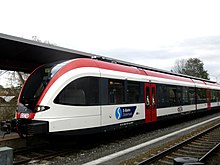
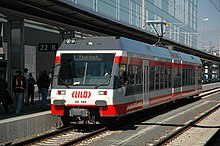
-
Linz Local Railway (LILO)
- ET 22 151–158 (2000), GTW 2/6 ( two-system railcar for 750 V DC and 15 kV AC voltage )
- ET 22 159–164 (2005), GTW 2/6 (750 V = / 15 kV ~ )
- → see also section History / First Generation
- The ET 22 of the second series were initially designed as dual-current vehicles for DC and AC voltage, as was the case with the first copy of the first series. The remaining seven DC GTWs were retrofitted for AC operation because the LILO trains have been terminating at Linz Central Station since 2005 .
-
Graz-Köflacher-Bahn- und Busbetrieb (GKB)
- VT 5063.001–013 (2010–2011), GTW 2/8 (with two diesel engines)
- Due to the increasing number of passengers and in order to replace vehicles that are almost 30 years old, the Graz-Köflacher-Bahn acquired 13 three-part GTWs.
-
Steiermarkbahn and Bus (StB), until 2018 Steiermärkische Landesbahnen (STLB)
- VT 5062.001–003 (2010–2011), GTW 2/6 (with two diesel engines) for the Graz – Gleisdorf – Weiz route
- ET 4062.001–003 (2010–2011), GTW 2/6 (15 kV, 16.7 Hz) for the Graz – Peggau – Übelbach line
- The Styrian State Railways procured three electric and three diesel-electric GTW 2/6 for use in S-Bahn traffic in the greater Graz area . With the exception of the drive and heating, both vehicle types are identical. Up to four vehicles can be coupled, whereby a mixed operation of electric and diesel-powered trains is possible. Due to delays in the approval process , the VT 5062 could only be handed over to operation in November 2011, which led to disagreements between the manufacturer and the customer.
- On May 6, 2015, the ET 4062.001 collided head-on with the ET 4062.002 in the Waldstein railway accident . Two people were killed and eight injured. Stadler came under fire because the horizontally ribbed buffers should have prevented one of the 4062.002 from climbing onto the frame of the 4062.002 during the collision. Because this did not work, the shock absorbing elements built into the frame under the driver's cab were ineffective and the driver's survival space was impaired. The manufacturer proved that the crashed GTW had met their more stringent crashworthiness and that the climb was due to the high collision speed of 70 instead of the standardized 36 km / h. The badly damaged ET 4062.002 was repaired by Stadler in 2016. At the time, it was not known whether the other GTW should also be repaired or replaced by a new vehicle.
France
-
Ligne de Cerdagne , meter gauge,
- Z 151–152 (2004), GTW 2/6 (850 V direct voltage via a busbar coated from above)
→ see also section Technical Description / Third Generation
- Z 151–152 (2004), GTW 2/6 (850 V direct voltage via a busbar coated from above)
-
Panoramique des Dômes , meter-gauge rack railway
- 1–4 (2011–2012), GTW 2/6 (1500 V DC voltage, contact line)
→ see also section Technical description / gear drive
- 1–4 (2011–2012), GTW 2/6 (1500 V DC voltage, contact line)
Greece
-
Organismos Sidirodromon Ellados (OSE), Peloponnese Railway
- 4501–4512 (2003–2004), GTW 2/6 (meter gauge)
- Organismos Sidirodromon Ellados (OSE)
- 560 101–117 / 901–917 / 201–217 (2004), GTW 2/6 (standard gauge)
- In 1999 the OSE ordered standard and meter gauge diesel multiple units. While the standard-gauge vehicles were supposed to cope with the increased traffic of the Olympic Summer Games in the greater Athens area, there was no operational concept for the narrow-gauge trains. The Peloponnese Railway was out of service due to poor track condition. The public prosecutor's office investigated those responsible at the OSE for the purchase of the meter-gauge GTW. They are too heavy for the tracks and bridges, although the weight has been reduced through various adjustments. The toilet is missing and the fuel tanks are only half the size of the standard-gauge GTW. In 2006 they were in operation without any technical changes. Because no standing passengers are allowed, they often run in double traction .
- On July 12, 2007, 53 passengers were slightly injured in a frontal collision of a freight train with the GTW 560 103/903/203 on the outskirts of Athens.
Italy

-
South Tyrolean Transport Structures (STA) Vinschgau Railway
- ATR 100 001–012 (2004–2006), GTW 2/6 twin-engine diesel railcars
- The Autonomous Province of Bolzano reactivated the Vinschgau Railway in 2004, the operation of which was given up in 1991 by the Italian State Railways FS. In addition to investments in the infrastructure , new vehicles were also necessary. Until then, it was customary in Italy to procure rolling stock from local manufacturers.
- → see also section History / Third Generation
- On April 12, 2010, a GTW of the Vinschgerbahn between Latsch and Kastelbell was hit by a 400 cubic meter, leaky irrigation pipe triggered mud avalanche and pushed out of the track. The rubble also penetrated the interior of the car. Nine people died and 28 were injured. Four years later, the badly damaged train was still confiscated by the Italian public prosecutor and later had to be retired.
-
Sistemi Territoriali (ST) Adria - Mestre - Venezia Santa Lucia
- ATR 110 201–202 (2006), GTW 2/6 twin-engine diesel multiple units
- ATR 120 401–404 (2006), GTW 2/6 twin-engine diesel railcars, half trains coupled to GTW 4/12
- ATR 126 001–004 (2012), GTW 2/6 twin-engine diesel railcars, half trains coupled to GTW 4/12
- Sistemi Territoriali operates several railway lines in Veneto . Stadler's GTWs are the first vehicles in a blue and white design to operate in the greater Venice area.
-
Ferrovie Udine – Cividale (FUC)
- ATR 110 001–002 (2006), GTW 2/6 twin-engine diesel multiple units
- The Udine – Cividale line in Friuli is operated by the independent FUC, which was founded in 2005. However, the two GTW procured the Sistemi Territoriali. Its dark blue and white paintwork was adapted to the use on the FUC.
- Ferrovie del Sud Est (FSE)
-
Trenord (TN), formerly Ferrovie Nord Milano (FNM)
- ATR 115 001–008 (2011–2012), GTW 2/6 twin-engine diesel multiple units ( railway line Brescia – Iseo – Edolo )
- ATR 125 001–011 (2011–2012), GTW 4/12 four-engine diesel multiple units ( route Milano – Lecco )
- ATR 125 101-105 (2015), GTW 4/12 four-engine diesel multiple units
- ATR 125 106-109 (2017), GTW 4/12 four-engine diesel multiple units
- Ferrovienord procured 19 diesel-electric GTWs. The order was remarkable in that two new Pesa railcars had been in use on the Brescia – Edolo route since 2009 . In 2015 another five GTW 4/2 were delivered. In 2016 the ATR 125 101–103 were stationed in the Cremona depot for the routes from Padua to Vercelli , Alessandria and Codogno . The ATR 125 104 and 105 came to Iseo to support the ATR 115 on the Brescia – Edolo route. The four ATR 125 106–109 of the latest generation are equipped with MAN diesel engines.
Netherlands
Arriva
→ Vehicles taken over by Veolia in 2017, see section Netherlands / Other operators
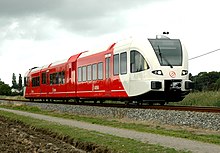
-
Arriva , Heerenveen ( Provinces of Groningen and Friesland )
- 10228-10244, 10247-10251 (2006-2010), GTW 2/6 (twin-engine diesel multiple units)
- of which 10228-10230 and 10244 with Germany package ( PZB )
- 10301–10327, 10345–10346 (2006–2010), GTW 2/8 (twin-engine diesel multiple units)
- including 10301-10305, 10345 and 10346 with Germany package
- 10228-10244, 10247-10251 (2006-2010), GTW 2/6 (twin-engine diesel multiple units)
- In addition to the sliding steps at 800 mm above the SOK , the vehicles that run empty in Germany are also equipped with those at a height of 550 mm, in order to comfortably serve both German and Dutch platform heights.
- Arriva had received the franchise for the regional lines in the provinces of Groningen and the province of Friesland and ordered 43 diesel-electric GTWs from Stadler. Since then, trains suitable for Germany have allowed a journey to Leer without changing trains.
→ see also section History / Fourth Generation - The strong increase in traffic prompted Arriva to supplement the two-part GTW 2/8 with an additional passenger module: The GTW 2/6 10236 and 10247-10251 were extended to GTW 10347-10351 and 10336 in 2014 at the Stadler plant in Bussnang, and in 2016 the GTW 10234 the three-part 10334.
- On November 18, 2016, the spurt 10327 “Jelle Zijlstra” collided with a milk truck on an unguarded level crossing near Winsum . Several people were injured and eleven had to be treated in hospitals.
- Names:
10228 Jan Uitham, 10229 Sjoukje Dijkstra , 10230 Ede Staal , 10231 Hotze Schuil, 10232 Foppe de Haan , 10233 Liesbeth List , 10237 Marianne Timmer , 10238 Foppe Inne Brouwer, 10239 Piet Oberman, 10240 Eise Eisinga , 10241 Ger Vaders, 10242 Samuel van Houten, 10243 Egbert Wagenborg , 10244 Anthony Winkler Prins
10301 Riemer en Annie , 10302 Bastiaan Jan Ader, 10303 Tiny Mulder, 10304 Hans Alders, 10305 Ubbo Emmius , 10306 Gerrit Krol, 10307 Frits Zernike , 10308 Heike Kamerlingh Onnes , 10309. Hendrik Nicolaas Werklingh Onnes , 10309 , 10310 Abe Lenstra , 10311 Hans Wiegel , 10312 M. Vasalis , 10313 Aletta H. Jacobs , 10314 Jopie Huisman, 10315 Abel Tasman , 10316 Wim Duisenberg , 10317 Willem Barentsz , 10318 Nienke van Hichtum , 10319 Marte Röling, 10320 Cees Bijlstra, 10321 Piet Paaltjens, 10322 Titus Brandsma , 10323 Willem Albert Scholten, 10324 Sicco Mansholt , 10325 JJ Nooitgedagt, 10326 MC Escher , 10327 Jelle Zijlstra , 10334 Fedde Schurer , 10335 Jan de Roos, 10336 Tonny van Leeuwen, 10 345 Ruurt Hazewinkel, 10346 Pieter Jelles Troelstra , 10347 Mata Hari , 10348 Evert van Benthem, 10349 Jan Pelleboer, 10350 Johan van Veen, 10351 Belcampo

- Arriva, Heerenveen ( Province of Zuid-Holland )
- 10407 (2008), GTW 2/6 (1500 V =)
- 10408 (2011), GTW 2/6 (1500 V =)
- 10501-10506 (2008), GTW 2/8 (1500 V =)
- 10509-10510 (2011), GTW 2/8 (1500 V =)
- In 2008, seven electric GTWs were put into operation for the Geldermalsen - Dordrecht route . In 2011 three more trains were added.
- Names:
10407 Frank Wels , 10408 Trijntje , 10501 Ronald Bandell, 10502 Baron van Verschuer , 10503 Adriaan Volker, 10504 Ida Gerhardt, 10505 Andries Dirk Copier , 10506 Maarten Schakel, 10509 Jan van Arkel , 10510 Hendrik Hamel
-
Arriva, Vechtdallijnen ( Zwolle - Emmen )
- 10411-10413 (2012), GTW 2/6 (1500 V =)
- 10514-10524 (2012), GTW 2/8 (1500 V =)
- In 2012, the Siedlce plant supplied 14 electric GTWs for the Zwolle – Emmen route with particularly high-quality interior fittings with lounge , business and rest compartments. In order to give passengers more legroom, the size of the windows in the low-floor area of the train was adjusted. Four windows got bigger and the fifth got smaller. In 2016, three trains were extended to GTW 2/8.
- The GTW 10520 collided on February 23, 2016 between Dalfsen and Ommen on a guarded level crossing with a mobile lifting platform . The driver was killed and several passengers were injured.
- Names:
10411 Krishnamurti , 10412 Herman Brood , 10413 Jannes , 10514 Johan Rudolph Thorbecke , 10515 Harry Muskee, 10516 Daniël Lohues, 10517 War Child , 10518 Willem Jan Baron van Dedem, 10519 Jeroen Krabbé , 10520 Ilse DeLange , 10521 Relus ter Beek, 10522 Roelof Zegering Hadders, 10523 Mien Ruys , 10524 Jaap en Aleid Rensen, 10525 (ex-Connexxion 5037) Johan Rudolph Thorbecke
- Arriva, Achterhoek ( Achterhoek - Rivierenland)
- 10252-10264 (2012), GTW 2/6 (twin-engine diesel multiple units)
- 10365-10375 (2012), GTW 2/8 (twin-engine diesel multiple units)
- To increase the legroom, the room layout in the low-floor area was again adjusted. Basically, the vehicles correspond to the vehicles delivered to Arriva since 2005. However, they have a newly developed drive with Deutz - instead of MAN engines.
- On August 30, 2017, the drive module of the Spurt 10256 in Hemmen- Dodewaard burned out.
- Each train is named after a person who is important to the region:
10252 Ottho Gerhard Heldring , 10253 Herman Hulshof, 10254 Simon Tahamata , 10255 Harm Edens, 10256 Piet Oudolf , 10257 Harry Sacksioni , 10258 Frans Godard van Lynden van Hemmen, 10259 Peter Cuyper, 10260 Ellen ten Damme , 10261 Flipje, 10262 Dames Jolink, 10263 JN Daalderop10264 Alfred Mozer , 10365 Hendrik Lorentz , 10366 Annemarie Jorritsma , 10367 Guus Hiddink , 10368 Arne Jansen , 10369 Gijs Scholten van Aschat, 10370 Piet Mondriaan , 10371 Mary Dresselhuys, 10372 Hannes, 10373 yr. Huub van Nispen van Sevenaer, 10374 Jan Terlouw , 10375 Clemens Cornielje
- Arriva equipped all 96 GTWs with cameras aimed at the track, the images of which are evaluated in the event of an incident. In addition to Arriva, the police and the railway safety authorities also have access to the images.
Other operators

-
Veolia Transport , Arriva since 2018
- 7201–7210 (2006–2007), GTW 2/6 (twin-engine diesel multiple units) (EVN 95 84 520 72xx-x)
-
- since 2018 Arriva 10 276-10 281
- 7207-7210 extended to GTW 2/8 7357-7360
- since 2018 Arriva 10388-10391
- 7351–7356 (2007), GTW 2/8 (twin-engine diesel multiple units) (EVN 95 84 530 73xx-x)
- since 2018 Arriva 10382-10387
- 7501–7505 (2008), GTW 2/6 (1500 V =)
- since 2018 Arriva 10426-10430
- 7651-7653 (2008), GTW 2/8 (1500 V =)
- since 2018 Arriva 10530-10532
- → see also section History / Fourth Generation
- Veolia was awarded the contract by the Province of Limburg for the Nijmegen – Venlo - Roermond route with a term of ten years and procured 16 diesel GTWs. In order to enable the trains to be manufactured on time, production was divided between various Stadler locations. In contrast to the Arriva trains, the Veolia GTW were equipped with 2 + 3 seating. At Veolia the trains ran under the name Velios. At the beginning of the 2017 timetable year , they were taken over and renumbered by Arriva.
- On April 18, 2018, a fire broke out in the drive module of the Arriva 10278 (formerly Veolia 7203) in Venray .
- The GTW carried the names of well-known people from the province of Limburg at Veolia :
7201 Connie Palmen , 7202 Beppie Kraft, 7203 Sint Servaas, 7204 Jack Poels, 7205 Jan Klaassens, 7206 Joris Ivens , 7351 Jan van Kuyk, 7352 Chriet Titulaer, 7353 Pater Karel, 7354 Titus Brandsma , 7355 Mat Vestjens, 7356 Wilhelm Tell , 7357 Jan Linders, 7358 Willem Nijholt, 7359 Bart Brentjes, 7360 Andre Rieu , 7501 Pieke Dassen, 7503 Beppie Kraft, 7651 Sjef Diederen, 7653 André Rieu
- since 2018 Arriva 10 276-10 281

-
Connexxion
- 5037 (2012), GTW 2/8 (1500 V =)
- since 2016 Arriva 10525 as a replacement for the accident 10520
- Connexxion's loner replaced a Plan V train that had reached the end of its life. From December 2016 the Arriva train will be used as a replacement for the Spurt 10520, which had an accident in Dalfsen on February 23, 2016. Instead, Connexxion ordered two Flirt .
-
Hermes (Breng)
- 5041–5049 (2012), GTW 2/8 (three-engine diesel multiple units)
- The three-part GTW of the Connexxion subsidiary Hermes, which mainly operates as a bus operator, operate between Arnhem and Doetinchem under the brand name “Breng”. They offer along with the Arriva trains Arnhem- Winterswijk one quarter of an hour at. Four larger and a fifth small window in the low-floor area allow more legroom. The paintwork of the Breng-GTW matches that of the blue intercity buses.
Russia
-
Metro wagon machine
- two four-axle traction modules for the prototype DP-M-001 (2013)
→ see section History / Drive modules GTW +
- two four-axle traction modules for the prototype DP-M-001 (2013)
Slovakia

-
Železničná spoločnosť Slovensko (ŽSSK), Tatra Electric Railway , meter gauge
- 425.951–964 (2001–2002), GTW 2/6 (1500 V =), license construction at ŽOS Vrútky (EVN 94 56 0 425 9xx-x)
- 425.965 (2005), GTW 2/6 (1500 V =), built by ŽOS Vrútky
-
- In connection with the bid for the 2006 Winter Olympics , the then railways of the Slovak Republic (ŽSR) ordered new railcars for the Tatra Electric Railway (TEŽ) located in the High Tatras . The meter- gauge GTWs supplied from 2000 onwards replaced the outdated class 420.95 railcars within a very short time .
- → see also section History / Second Generation
- In 2018, ŽSSK ordered five two-part GTWs with mixed adhesion and cogwheel operation and 91 seats for the Štrba – Štrbské Pleso (OŽ) rack railway. The trains largely correspond to the cogwheel GTW of the MVR and TPC , but are one compartment shorter for profile reasons . They will replace the 405.95 series from 1969. In the future, through trains will use the TEŽ and OŽ routes. For this purpose, the ŽSSK will procure additional sets with adhesion and gear operation, which will then replace the adhesion GTW of the 425.95 series.
- Železničná spoločnosť Slovensko (ŽSSK), standard gauge
- ŽSSK 840.001-006 (2002-2003), GTW 2/6; Diesel railcar (EVN 95 56 7 840 00x-x)
Spain
-
Ferrocarrils de la Generalitat de Catalunya (FGC)
-
Cremallera de Montserrat , meter-gauge rack railway
- AM1 – AM5 (2003), GTW Beh 2/6 (1500 V =)
-
Cremallera de Montserrat , meter-gauge rack railway
-
- In 2003, the 5 km long rack railway to Montserrat, which had been closed since 1957, was resumed with five new GTWs.
- Cremallera de Núria , meter-gauge rack railway
- A10-A11 (2003), GTW Beh 2/6 (1500 V =)
- → For the geared GTW of the Montserrat and Núriabahn, see also section Technical Description / Gear Drive
- Lleida - La Pobla de Segur ( Iberian broad gauge 1668 mm)
-
- 331.01–02 (2016), GTW 2/6, twin-engine diesel multiple units
- The broad-gauge GTW, together with infrastructure measures, enable a denser timetable and shorter travel times on the former RENFE line . The two vehicles of the FGC were built together with the trains for eBART , which, apart from the track gauge, has comparable technical parameters.
Czech Republic
- České dráhy (ČD)
- In 2019, the Czech Railways ČD bought twelve diesel multiple units from DB Regio for 7.5 million euros. The GTW will be modernized and then used in the Olomouc region.
- Arriva vlaky
Arriva vlaky took over twelve railcars from DB Kurhessenbahn, which, after modernization, are to be used in the border area with Slovakia by 2021.
United States

-
New Jersey Transit , River Line ( Camden - Trenton )
- 3501–3520 (2002–2003), GTW 2/6 (diesel multiple units)
- The 55-kilometer River Line is a mass transit system in Philadelphia . The very special trains run on a former freight line and get into the city center like a tram with tight curve radii. Like the GTW in Austin, they are equipped with indicators and a braking system adapted to tram operation.
- Capital Metropolitan Transportation Authority (Capital Metro), Austin, Texas
- 101-106 (2007), GTW 2/6 (twin-engine diesel multiple units)
- 201–204 (2017), GTW 2/6 (twin-engine diesel multiple units)
- In 2004, the urban bus operator Capital Metro was able to assert itself for the operation of an S-Bahn and ordered diesel-powered GTWs. The 52.5 km route connects Austin with the suburb of Leander . In 2017, Stadler delivered another four trains in order to be able to provide sufficient capacity for the increasing number of passengers.
- Denton County Transportation Authority (DCTA), Dallas
- 101–111 (2011–2012), GTW 2/6 (twin-engine diesel multiple units)
- Diesel GTWs operate under the name A-train on the 34 kilometer stretch from Denton to Carrollton .
-
Bay Area Rapid Transit (BART), Oakland , California
- 101-108 (2017), GTW 2/6 DMU-2 (twin-engine diesel multiple units)
- Stadler was able to deliver eight GTW 2/6 for the standard-gauge eBART route currently under construction. The vehicles are based on the 37 vehicles delivered to New Jersey and Texas. The new feeder line runs between the lanes of a freeway and connects the eBART terminus in Pittsburg / Bay Point with Antioch, around 16 kilometers away . The other BART lines are operated in Indian broad gauge of 1676 mm.
Variant overview
Following the example of the Swiss series designations, Stadler designates the different variants with an x / y, where x indicates the number of driven axles and y the total number of axles.
The abbreviations used by the railway companies are linked to the corresponding section in the Customers and Operators chapter .
First generation
| Stadler GTW - first generation | ||||||||
|---|---|---|---|---|---|---|---|---|
| Type designation: |
BTI Be 2/6 CEV Be 2/6 |
MThB Bm 596 | MThB RABe 526 | LILO ET 22 | HLB 646 |
DB region 646 |
UBB 646 | |
| Numbering: |
BTI: 501-507, 509-510 CEV: 7001-7004 |
596 601-603 | 526 680-689 | 151-164 | 101-130 | 001-030, 201-213 |
101-114, 121-129 |
|
| Number: |
BTI: 9 + 1 middle section CEV: 4 |
3 | 10 | 8 + 6 (second series) |
30th | 43 | 23 | |
| Years of construction: | 1997-1998, 2007 | 1996 | 1998 | 2000, 2005 | 1999, 2001 | 2000-2001 | 2000-2002 | |
| Axis formula : | 2'Bo2 ' | |||||||
| Gauge : | 1000 mm | 1435 mm | ||||||
| Length over coupling / buffer: | 30,100 m | 37.144 m | 37,600 m | 38,200 m | 38.660 m | |||
| Width: | 2700 mm | 3000 mm | ||||||
| Longitudinal compressive force: | 800 kN | 1500 kN | ||||||
| Axle base drive module: Trailer bogies: |
1800 mm 1600 mm |
2000 mm 2000 mm |
2100 mm 1900 mm |
2000 mm 2000 mm |
||||
| Service mass: | 37 t | 47.5 t | 57 t | 60 t | 52 t | 54 t | ||
| Top speed: | 80 km / h | 120 km / h | 130 km / h | 120 km / h | 120 km / h | |||
| Short term output: | 592 kW | 760 kW | ||||||
| Continuous output: | 320 kW | 424 kW | 520 kW | 420 kW | ||||
| Starting tractive effort: | 65 kN | 61 kN | 70 kN | 62 kN | ||||
| Driving wheel diameter (new): Impeller (new): |
750 mm 660 mm |
860 mm 680 mm |
||||||
| Power system : |
BTI: 1200 V = CEV: 900 V = |
diesel-electric | 15 kV, 16.7 Hz | 750 V = 15 kV, 16.7 Hz |
diesel-electric | |||
| Diesel engine manufacturer: Type: Power: |
- |
MTU twelve-cylinder V 550 kW |
- | MTU twelve-cylinder V 550 kW |
||||
| 1st class seats: 2nd class: |
- BTI: 88, CEV: 84 |
- 134 |
12 106 |
- 126, 118 (second series) |
- 120 |
15 93 |
- 126 |
|
| Standing places (4 people / m²): | BTI: 92, CEV: 96 | 106 | 82 | 108, 112 (2nd series) | 103 | 104 | 91 | |
| Floor height low floor : high floor: |
370 mm 845 mm |
585 mm 985 mm |
585 mm 1000 mm |
585 mm 1000 mm |
760 mm 1000 mm |
585 mm 1000 mm |
||
| Coupling type: |
BTI: + GF + CEV: compensating coupling |
Screw coupling | Scharfenberg | |||||
| Air suspension: | Running bogies | |||||||
| Particularities: | WC | Air conditioning, toilet | Air conditioning, toilet | |||||
| Source: | ||||||||
Second generation
| Stadler GTW - second generation | ||||||||
|---|---|---|---|---|---|---|---|---|
| Type designation: | OSE 560 | OSE 4500 | ŽSSK 425.95 | CJ ABe 2/6 | YSteC Be 2/6 | ŽSSK 860 | NJT GTW | SBB RABe 520 |
| Numbering: | 561-577 | 4501-4512 | 951-965 | 631-634 | 2000-2001 | 001-006 | 3501-3520 | 520,000-016 |
| Number: | 17th | 12 | 14 + 1 | 4th | 2 | 6th | 20th | 17th |
| Years of construction: | 2002-2003 | 2003-2004 | 2001, 2005 | 2001 | 2001 | 2002-2003 | 2003 | 2002 |
| Axis formula : | 2'Bo2 ' | 2'2'Bo2 ' | ||||||
| Gauge : | 1435 mm | 1000 mm | 1000 mm | 1435 mm | ||||
| Length over coupling / buffer: | 35,189 m | 35.1 m | 33,184 m | 33.004 m | 33.784 m | 38,470 m | 31.2 m | 53,434 m |
| Width: | 3000 mm | 2700 mm | 3000 mm | 2650 mm | ||||
| Longitudinal compressive force: | 1500 kN | 800 kN | 1500 kN | 1200 kN | ||||
| Axle base drive module: Trailer bogies: |
2100 mm 2100 mm |
1800 mm 1600 mm |
2100 mm 1600 mm |
2100 mm 2100 mm |
||||
| Service mass: | 56 t | 54 t | 38 t | 41 t | 46.5 t | 57.8 t | 55 t | 78.5 t |
| Top speed: | 115 km / h | 100 km / h | 80 km / h | 90 km / h | 80 km / h | 115 km / h | 110 km / h | 115 km / h |
| Short term output: | 400 kW | 400 kW | 600 kW | 592 kW | 420 kW | 400 kW | 760 kW | |
| Continuous output: | 320 kW | 520 kW | ||||||
| Starting tractive effort: | 55 kN | 65 kN | 69 kN | 77 kN | ||||
| Driving wheel diameter (new): Impeller (new): |
860 mm 750 mm |
750 mm 680 mm |
860 mm 750 mm |
860 mm 750 mm |
||||
| Power system : | diesel-electric | 1500 V = | 15 kV, 16.7 Hz | diesel-electric | diesel-electric | 15 kV, 16.7 Hz | ||
| Manufacturer diesel engine: Type: Power: |
MTU twelve-cylinder V 550 kW |
- |
MTU twelve-cylinder V 550 kW |
- | - | |||
First class seats : second class: |
- 94 |
- 76 |
- 108 |
9 78 |
- 100 |
- 110 |
- |
12 127 |
| Standing places (4 people / m²): | 106 | 92 | 89 | 74 | 119 | 179 | ||
| Floor height low floor : high floor: |
585 mm 1000 mm |
370 mm 845 mm |
615 mm 1000 mm |
400 mm 1000 mm |
||||
| Coupling type: | Scharfenberg | + GF + | Compensating coupling | + GF + | Scharfenberg | Schwab | ||
| Air suspension: | Running and motor bogies | Running bogies | Running and motor bogies | |||||
| Particularities: | Air conditioning, toilet | air conditioning | WC | Air conditioning, toilet | WC | |||
| Source: | ||||||||
Third generation
| Stadler GTW - third generation | ||||||||
|---|---|---|---|---|---|---|---|---|
| Type designation: |
RM RABe 526 Thurbo RABe 526 |
FGC Beh 2/6 | STA ATR 100 | SNCF Z 150 | ST ATR 110 | ST ATR 120 | ||
| Numbering: |
RM: 260-265 Thurbo: 701-708, 719-751 |
RM: 280-286 Thurbo: 752-805 |
AM1-AM5 (Montserrat) |
A10 – A11 (Ribes– Núria) |
100 001-012 | 151-152 | 001-002, 201-202 |
401 + 402, 403 + 404 |
| Number: |
RM: 6 Thurbo: 41 |
RM: 7 Thurbo: 29 + 10 + 15 |
5 | 2 | 8 + 4 | 2 | 4th | 2 |
| Years of construction: | 2003-2005 | 2004-2013 | 2002-2003 | 2003 | 2004, 2006 | 2003-2004 | 2006 | 2006 |
| Axis formula : | 2'Bo2 ' | 2'2'Bo2 ' | 2'Bozz2 ' | 2'Bo2 ' | 2'Bo2 ' | 2'Bo2 ' | 2'Bo2 '+ 2'Bo2' | |
| Gauge : | 1435 mm | 1000 mm | 1435 mm | 1000 mm | 1435 mm | |||
| Length over coupling / buffer: |
RM: 38,490 m Thurbo: 39,400 m |
RM: 53.537 m Thurbo: 54.447 m |
36,432 m | 39,500 m | 31.182 m | 39,500 m | 77.330 m | |
| Width: | 3000 mm | 2600 mm | 3000 mm | 2600 mm | 3000 mm | |||
| Longitudinal compressive force: | 1500 kN | 1500 kN | 1500 kN | |||||
| Axle base drive module: Trailer bogies: |
2100 mm 2100 mm |
2540 mm 1800 mm |
2100 mm 2100 mm |
2540 mm 1900 mm |
2100 mm 2100 mm |
|||
| Service mass: |
RM: 65 t Thurbo: 63 t |
RM: 84 t Thurbo: 82 t |
45 t | 66 t | 41 t | 68 t | 136 t | |
| Maximum speed of adhesion: rack: |
140 km / h |
45 km / h 30 km / h |
140 km / h |
80 km / h |
140 km / h |
|||
| Short term output: | 1100 kW | 850 kW | 600 kW | 700 kW | 600 kW | 2 × 600 kW | ||
| Continuous output: | 700 kW | 600 kW | 600 kW | |||||
| Starting tractive effort: | 80 kN | 110 kN | 80 kN | 80 kN | 2 × 80 kN | |||
| Driving wheel diameter (new): Impeller (new): |
860 mm 750 mm |
776 mm 660 mm |
860 mm 750 mm |
776 mm 660 mm |
860 mm 750 mm |
|||
| Rack system: | Dept | |||||||
| Power system : | 15 kV, 16.7 Hz | 1500 V = | diesel-electric | 850 V = | diesel-electric | |||
| Manufacturer diesel engine: Type: Power: |
- | - |
MAN six-cylinder 2 × 390 kW |
- | MAN six-cylinder 2 × 390 kW |
MAN six-cylinder 4 × 390 kW |
||
| First class seats: second class: |
RM: 15, Thurbo: 16 88, 102 |
RM: 15, Thurbo: 16 88, 162 |
- 108 |
- 104 |
- 86 |
- 102 |
- 230 |
|
| Standing places (4 people / m²): | RM: 107, Thurbo: 110 | RM: 168, Thurbo: 163 | 110 | |||||
| Floor height low floor : high floor: |
585 mm 1000 mm |
595 mm 925 mm |
585 mm 1040 mm |
585 mm 996 mm |
||||
| Coupling type: | Schwab | BSI | Scharfenberg | automatic | Scharfenberg | |||
| Air suspension: | Running and motor bogies | |||||||
| Particularities: | Air conditioning, toilet | Air conditioning, toilet | air conditioning | Air conditioning, toilet | ||||
| Source: | RM , Thurbo: | |||||||
Fourth generation and GTW +
| Stadler GTW - fourth generation (Part I) | ||||||||
|---|---|---|---|---|---|---|---|---|
| Type designation: |
Arriva Spurt Veolia GTW |
Arriva Spurt Veolia GTW |
Arriva Spurt Veolia GTW |
Arriva Spurt Veolia GTW Connexxion GTW Breng GTW |
Capital Metro GTW 2/6 |
GKB VT 5063 |
STLB VT 5062 |
STLB ET 4062 |
| Numbering: |
Arriva: 10 228-244, 10 247-251, 10 252-264 Veolia: 7201-7210 |
Arriva: 10 301-327, 10 345-346, 10 365-375 Veolia: 7351-7356 |
Arriva: 10 407-408, 10 411-413 Veolia: 7501-7505 |
Arriva: 10 501-506, 10 509-510, 10 514-524 Veolia: 7651-7653 Conn .: 5037 Breng: 5041-5049 |
101-110, 201-204 |
001-013 | 001-003 | 001-003 |
| Number: |
Arriva: 16 + 6 + 13 Veolia: 10 |
Arriva: 27 + 2 + 11 Veolia: 6 |
Arriva: 1 + 1 + 3 Veolia: 5 |
Arriva: 6 + 2 + 11 Veolia: 3 Conn .: 1 Breng: 9 |
6 + 4 | 13 | 3 | 3 |
| Years of construction: | 2006-2010, 2012 | 2006-2010, 2012 | 2008, 2011, 2012 | 2008, 2011–2012 | 2007, 2017 | 2010-2011 | 2010-2011 | |
| Axis formula : | 2'Bo2 ' | 2'2'Bo2 ' | 2'Bo2 ' | 2'2'Bo2 ' | 2'Bo2 ' | 2'2'Bo2 ' | 2'Bo2 ' | |
| Gauge : | 1435 mm | |||||||
| Length over coupling / buffer: | 40.890 m | 55.937 m | 40.890 m | 55.937 m | 40.890 m | 55.937 m | 40.890 m | |
| Width: | 2950 mm | |||||||
| Longitudinal compressive force: | 1500 kN | |||||||
| Axle base drive module: Trailer bogies: |
2100 mm 2100 mm |
|||||||
| Service weight approx .: |
Arriva: 68 t Veolia: 69 t |
Arriva: 87 t Veolia: 88 t |
Arriva: 64 t Veolia: 65.5 t |
Arriva: 82 t Veolia: 84.5 t Conn .: 83 t Breng: 89 t |
72 t | 93 t | 71 t | 68 t |
| Top speed: | 140 km / h | |||||||
| Short term output: | 600 kW | 1100 kW | 470 kW 101ff 600 kW 201ff |
640 kW | 800 kW | 1100 kW | ||
| Starting tractive effort: | 80 kN | |||||||
| Driving wheel diameter (new): Impeller (new): |
860 mm 750 mm |
860 mm, Conn./Breng: 870 mm 750 mm |
860/870 mm 750 mm |
860 mm 750 mm |
860 mm 750 mm |
|||
| Power system: | diesel-electric | 1500 V = | diesel-electric | 15 kV, 16.7 Hz | ||||
| First class seats: second class: |
Arriva: 8 Veolia 16 100/111 Veolia 107 |
16 169/170 Veolia: 176 |
Arriva: - Veolia: 16 Arriva: 113 Veolia: 107 |
Arr .: Co .: - Veo .: 16 Br .: 8 Arr .: 172 Co .: 155 Veo .: 176 Br .: 174 |
- 108 |
- 165 |
- 97 |
|
| Standing places (4 people / m²): |
Arriva: 106 Veolia: 96 |
Arriva: 214 Veolia: 139 |
Arriva: 108 Veolia: 96 |
Arriva: 172 Veolia: 139 |
96 | |||
| Floor height low floor : high floor: |
830 mm 996 mm |
600 mm 1000 mm |
600 mm 998 mm |
600 mm 997 mm |
||||
| Coupling type: | Scharfenberg | |||||||
| Air suspension: | Running and motor bogies | |||||||
| Particularities: | Air conditioning, toilet Connexxion GTW: prepared for toilet installation | Air conditioning, meets requirements for tram operation |
Air conditioning, toilet | |||||
| Source: | ||||||||
| Stadler GTW - fourth generation (Part II) | |||||||
|---|---|---|---|---|---|---|---|
| Type designation: | ODEG 646 | FNM ATR 115 | FNM ATR 125 | TCD GTW 2/6 |
DCTA GTW 2/6 BART GTW 2/6 |
FGC 331 |
MVR ABeh 2/6 TPC ABeh 2/6 |
| Numbering: | 040-045 | x01-x08 | x01-x11 | 1-4 |
DCTA: 101-111 BART: 101-108 |
01-02 |
MVR: 7501-7508 TPC: 541-547 |
| Number: | 6th | 8th | 11 | 4th |
DCTA: 11 BEARD : 8 |
2 |
MVR: 4 + 4 TPC: 7 |
| Years of construction: | 2011 | 2011 | 2012 |
DCTA: 2012 BEARD : 2017 |
2016 | 2015-2017 | |
| Axis formula : | 2'Bo2 ' | 2'Bo2 ' | 2'Bo2 '+ 2'Bo2' | 2'Bozz2 ' | 2'Bo2 ' | 2'Bo2 ' | 2'Bozz2 ' |
| Gauge : | 1435 mm | 1000 mm | 1435 mm | 1668 mm | 1000 mm | ||
| Length over coupling / buffer: | 40.890 m | 39,500 m | 77.330 m | 36,432 m | 40.890 m | 40.890 m | 39.234 m |
| Width: | 3000 mm | 2600 mm | 2950 mm | 2950 mm | 2650 mm | ||
| Longitudinal compressive force: | 1500 kN | 800 kN | 1500 kN | 800 kN | 800 kN | ||
| Axle base drive module: Trailer bogies: |
2100 mm 2100 mm |
2100 mm 2100 mm |
2100 mm 2100 mm |
2540 mm 1800 mm |
2100 mm 2100 mm |
2100 mm 2100 mm |
2480 mm 1900 mm |
| Service mass: | 72 t | 67 t | 136 t | 60 t | 73.275 t | 54 t | |
| Maximum speed of adhesion: rack: |
140 km / h |
30 km / h |
120 km / h (75 mph) |
120 km / h |
80 km / h 40 km / h |
||
| Short term output: | 764 kW | 600 kW | 1200 kW | 700 kW |
DCTA: 470 kW BART: 600 kW |
600 kW | 900 kW |
| Starting traction adhesion: Gear: |
80 kN |
80 kN |
160 kN |
130 kN |
80 kN |
80 kN |
70 kN 135 kN |
| Driving wheel diameter (new): Impeller (new): |
860 mm 750 mm |
795 mm 666 mm |
860 mm 750 mm |
870 mm 750 mm |
798 mm 700 mm |
||
| Gear system: | Strub |
MVR: Strub TPC: Dept. |
|||||
| Power system: | diesel-electric | 1500 V = | diesel-electric |
MVR: 900 V = TPC: 1500 V = |
|||
| Diesel engine power: | 2 × 382 kW | - | - | ||||
| First class seats: second class: |
- 100 |
- 111 |
- 243 |
- 100 |
- 104 |
- 104 |
MVR: 12 TPC: - MVR 94 TPC: 109 |
| Standing places (4 people / m²): | 158 | 100 | 96 | 97 | 65 | ||
| Floor height low floor : high floor: |
640 mm 996 mm |
830 mm 996 mm |
996 mm |
595 mm 950 mm |
DCTA: 600 mm BART: 620 mm DCTA: 1000 mm BART: 1020 mm |
620 mm 1020 mm |
400 mm 980 mm |
| Coupling type: | Scharfenberg | automatic | Scharfenberg | Schwab | |||
| Air suspension: | Running and motor bogies | ||||||
| Particularities: | Air conditioning, toilet | air conditioning | |||||
| Source: | |||||||
| Stadler GTW + | |
|---|---|
| Numbering: | DP-M-001 |
| Number: | 2 |
| Year of construction (s): | 2012 |
| Axis formula : | Bo'Bo ' |
| Gauge : | 1520 mm |
| Length over coupling: | 7,550 m |
| Width: | 3480 mm |
| Bogie axle base: | 2100 mm |
| Service mass: | 50 t |
| Top speed: | 160 km / h |
| Installed capacity: | 1119 kW |
| Driving wheel diameter: | 870 mm (new) |
| Motor type: | Cummins QSK38 |
| Power transmission: | diesel-electric |
| Tank capacity: | 2000 l |
| Floor height: | 1300 mm |
| Source: | |
literature
- Andreas Meier, Bruno Meier, Urs Meier, Urs Wieser: Diesel-electric articulated multiple unit GTW 2/6 in low-floor design. In: Swiss Railway Review . No. 5/1996. Minirex, ISSN 1022-7113 , pp. 177-189 and in: Eisenbahn-Revue International . No. 6/1996. Minirex, ISSN 1421-2811 . Pp. 212-224.
- Urs Walser: New vehicles for the Biel Täuffelen-Ins-Bahn. In: Swiss Railway Review . No. 3/1998, pp. 75-79.
- Jean-Marc Forclaz: Articulated railcar for the "Chemin de fer léger de la Riviera". In: Swiss Railway Review . No. 3/1998, p. 80.
- Urs Wieser, Anton Zimmermann: Electric articulated multiple unit Be 2/6 in low-floor design for BTI and CEV. In: Swiss Railway Review . No. 3/1998. Pp. 81-92.
- Urs Wieser, Peter Schoch, Matthias Emmenegger: Electric articulated multiple units RABe 526 680 - 689 for 15 kV / 16.7 Hz. In: Swiss Railway Review , No. 12/1998. Pp. 524-533.
- Werner Näf: The standard gauge GTW in Switzerland. Loki-Special No. 42. Stämpfli, Bern 2017, ISBN 978-3-7272-1790-6
- Theo Weiss: Stadler - From the tunnel locomotive to the double-decker train. Minirex, Lucerne 2010, ISBN 978-3-907014-33-2
- Helmut Petrovitsch: Flexible variety. Stadler's GTW regional railcars . in: Eisenbahn-Magazin, 3/2011, pp. 6–12 and 67–70.
Individual evidence
- ↑ Thomas Griesser Kym: Stadler in numbers: From an SME to a global corporation with 8,000 employees. In: St. Galler Tagblatt (online) of December 7, 2018.
- ↑ a b c d Theo Weiss: Stadler - From the tunnel locomotive to the double-decker train. P. 110
- ↑ Werner Näf: The standard gauge GTW of Switzerland. Loki Special No. 42. p. 121
- ↑ a b Werner Fritschi: The Thurbo vehicle and operating concept - an important element for low compensation. In: Swiss Railway Review . No. 6/2018. Pp. 326-328.
- ^ Walter von Andrian, Rüdiger Block: First GTW 2/6 local railcars for Germany presented. In: Swiss Railway Review. No. 1-2 / 1999, pp. 38-39.
- ↑ Hans-Jürgen Barteld, Walter von Andrian: GTW articulated railcar delivered to the airway in the USA 2.6. In: Swiss Railway Review. No. 10/2002, p. 471.
- ^ Walter von Andrian: New GTW variants. In: Swiss Railway Review. No. 12/1996, p. 514.
- ↑ Theo Stolz: Articulated railcar for Chemins de fer du Jura in delivery. In: Swiss Railway Review. No. 6/2001, p. 277.
- ^ Walter von Andrian: Articulated railcar RABe 520 for the Seetal line pre-installed. In: Swiss Railway Review. No. 4/2002, pp. 190-192.
- ^ Theo Weiss: Stadler - From the tunnel locomotive to the double-decker train. P. 113
- ↑ a b Theo Weiss: Stadler - From the tunnel locomotive to the double-decker train. P. 77
- ↑ a b c Sven Klein: The new generation of the GTW 2/6 articulated diesel multiple units. In: Swiss Railway Review. No. 5/2004, pp. 215-218.
- ↑ a b Theo Stolz: Meter-gauge articulated railcars for the Jura and the High Tatras. In: Swiss Railway Review, No. 5/2002. Pp. 230-238.
- ↑ a b Hans Hubli, Jürg Schöning, Ruedi Beutler: Articulated railcar RABe 526 for the Regionalverkehr Mittelland AG. In: Swiss Railway Review. No. 11/2003, pp. 498-503.
- ↑ Other GTW exports. In: Swiss Railway Review. No. 4/2002, p. 193.
- ↑ a b Sven Klein: The new generation of the articulated diesel multiple units GTW 2/6 (continued). In: Swiss Railway Review . No. 6/2004, pp. 253-260
- ↑ Helmut Petrovitsch, Walter von Andrian: reactivation of the Vinschger Bahn Merano - Malles. In: Swiss Railway Review. No. 12/2003, pp. 567-569.
- ↑ a b c d e f Sven Klein: The GTW articulated multiple units - a family of vehicles with a wide variety of variants. In: Swiss Railway Review. No. 12/2006, pp. 593-599.
- ↑ a b Theo Stolz: The meter-gauge articulated railcars of the SNCF for the Pyrenees. In: Eisenbahn-Revue International. No. 4/2009, pp. 205-207.
- ↑ a b c d e Walter Gabathuler: Stadler articulated railcar for the Netherlands. In: Swiss Railway Review. No. 6/2008, pp. 277-284.
- ^ Theo Weiss: Stadler - From the tunnel locomotive to the double-decker train. P. 78
- ^ Theo Weiss: Stadler - From the tunnel locomotive to the double-decker train. P. 114
- ↑ Toma Bacic, Mathias Rellstab: RZD-GTW in action. In: Swiss Railway Review. No. 8-9 / 2016, p. 407.
- ^ Mathias Rellstab: Stadler trains for Russia ?. In: Swiss Railway Review. No. 11/2010, p. 585.
- ↑ a b Drive part of the type GTW + for Metrowagonmash, Russia. Datasheet from Stadler Rail Bussnang, on reference archive . Stadler Rail website, accessed June 30, 2018
- ↑ a b Theo Weiss: Stadler - From the tunnel locomotive to the double-decker train. P. 175
- ↑ FLIRT³ electric low-floor multiple unit for the Łódź region, Poland. ( Memento of March 4, 2016 in the Internet Archive ) (PDF; 3.0 MB).
- ^ Mathias Rellstab: Stadler launches GTW successor - Arriva as first customer. In: Swiss Railway Review . No. 1/2018, pp. 24-25.
- ↑ a b Theo Stolz: Extended BLS-GTW in operation. In: Swiss Railway Review. No. 3/2010. P. 111
- ↑ Autumn problems with GTW. In: Swiss Railway Review. No. 1/2010. P. 38
- ^ Mathias Rellstab: Thurbo GTW with flirt. In: Swiss Railway Review. No. 10/2004, p. 274.
- ^ First GTW for Gelderland. In: Swiss Railway Review. No. 6/2012, p. 308.
- ↑ Everything for the passenger. ( Memento from July 13, 2018 in the Internet Archive ) In: Deutz Inside. The Deutz AG magazine . No. 2/2014, pp. 18-19. (PDF; 5.8 MB).
- ↑ a b Santiago Sorriano, Christian Meier, Urs Wieser: Reconstruction of the rack railway to the Montserrat monastery in Catalonia. In: Swiss Railway Review. No. 11/2000, pp. 497-501.
- ^ A b c d Hans Tribolet, Urs Wieser: New shuttle trains for the Täsch - Zermatt route. In: Swiss Railway Review. No. 12/2003, pp. 546-552.
- ^ Theo Weiss: Stadler - From the tunnel locomotive to the double-decker train. P. 105
- ^ A b Mathias Rellstab: First GTW for Catalonia - new order for Stadler. In: Swiss Railway Review. No. 6/2003, p. 271.
- ↑ a b c d Mathias Rellstab: Gear GTW for TPC and MVR. In: Swiss Railway Review. No. 6/2014, p. 317.
- ↑ a b c W. Ruetsch, M. Rellstab: MVR buy more gear GTW - Be 2/6 are sold. In: Swiss Railway Review. No. 5/2015 p. 217.
- ^ Werner Näf: BDeh 3/6. The eccentric from Lake Constance. In: The standard gauge GTW of Switzerland. Loki Special No. 42, pp. 42–53
- ↑ Werner Näf: The standard gauge GTW of Switzerland. Loki Special No. 42. p. 37
- ↑ Felix Hasler, Heinz Iwainsky, Gaudenz Burkart, Manfred Nachbaur: New electric motor coach Be 4/6 for Forchbahn AG. In: Swiss Railway Review. No. 2/2005, pp. 66-73.
- ↑ Heinz Iwainsky, Roland Zimmermann: Electric multiple units Be 4/8 31 - 32 for the Trogenerbahn. In: Swiss Railway Review. No. 7/2005, pp. 324-329.
- ↑ Walter von Andrian: New valley shuttle trains Spatz for Brünigbahn. In: Swiss Railway Review. No. 12/2002, pp. 570-572.
- ↑ Hans Schlunegger, Robert Jones: New low-floor articulated train units ABt 421 - 425 for the Berner Oberland Railways. In: Swiss Railway Review. No. 4/2006, pp. 179-185.
- ↑ Franz Karlen, Urs Wieser: Comfortable meter-gauge multiple units ABDeh 4/8 and ABDeh 4/10 (KOMET) for the Matterhorn - Gotthard Railway. In: Swiss Railway Review. No. 7/2008, pp. 330-337.
- ^ Mathias Rellstab: Control car at TRAVYS. In: Swiss Railway Review. No. 6/2008, p. 270
- ^ Mathias Rellstab: New control car for the WSB. In: Swiss Railway Review. No. 5/2007, p. 210
- ↑ ABt low-floor control car for AAR bus + bahn, Switzerland. Datasheet from Stadler Rail Bussnang, on reference archive . Stadler Rail website, accessed June 30, 2018 (PDF; 0.4 MB).
- ^ A b c Mathias Rellstab: Seehäsle-GTW to Italy ?. In: Swiss Railway Review. No. 5/2007, p. 235.
- ^ Mathias Rellstab: "M-Budget Trains" for Thurbo. In: Swiss Railway Review. No. 1/2011, p. 2.
- ↑ Three additional Thurbo GTW for traffic between Schaffhausen and Erzingen. In: Swiss Railway Review. No. 5/2013, p. 210.
- ^ Christian Frauenknecht: Accident GTW is running again. In: Swiss Railway Review. No. 4/2014, p. 166.
- ↑ a b c Fabian Scheeder: Refit for Seetal-GTW and sale of two trains to Thurbo. In: Swiss Railway Review. No. 7/2018, p. 348.
- ↑ Vehicles of the Thurbo regional train. On the Thurbo website, accessed on June 23, 2018 (PDF; 70 kB)
- ^ Walter von Andrian: SBB modernize the Seetalbahn GTW for the remaining service life. In: Swiss Railway Review. No. 4/2019, pp. 214-217.
- ↑ Matthias Rellstab: SBB are planning to convert the Seetal GTW. In: Swiss Railway Review. No. 7/2017. P. 318
- ↑ Martin Gut: News in brief. In: Railway amateur. No. 12/2018. P. 545
- ↑ Mathias Rellstab: BLS is investing in the S-Bahn fleet. In: Swiss Railway Review. No. 5/2009, pp. 242-243.
- ^ Mathias Rellstab: SBB take over BLS-GTW - but not until 2013. In: Swiss Railway Review. No. 12/2009, p. 10.
- ↑ Thurbo takes over SBB-GTW - and rents it back to SBB. In: Swiss Railway Review. No. 1/2018, p. 10.
- ^ A b c d Mathias Rellstab: MOB-GTW in Wil. In: Swiss Railway Review. No. 12/2017, p. 595.
- ^ Daniel Fankhauser: Rolling stock procurement for Aare Seeland mobil AG. In: Swiss Railway Review. No. 3/2006, pp. 146-147.
- ^ Daniel Fankhauser: New GTW in Ins. In: Swiss Railway Review. No. 11/2007, p. 525.
- ↑ a b c Fabian Scheeder: Refit for ASm-GTW. In: Swiss Railway Review. No. 10/2016, p. 483.
- ^ Mathias Rellstab: GTW in the Golden Pass design. In: Swiss Railway Review. No. 12/2011, p. 575.
- ^ Mathias Rellstab: TRAVYS-GTW for revision. In: Swiss Railway Review. No. 11/2016, p. 542.
- ↑ Fabian Scheeder: TRAVYS-GTW revised. In: Swiss Railway Review. No. 2/2017, p. 64.
- ↑ Theo Stolz: Challenging recovery of a derailed CJ train. In: Swiss Railway Review. No. 2/2012, pp. 110-111.
- ↑ Theo Stolz: Accident GTW is already driving again. In: Swiss Railway Review. No. 7/2012, p. 330.
- ^ Nouveau matériel roulant AOMC. Caractéristiques techniques. Media release by Transports Publics du Chablais (TPC) from February 26, 2016 (PDF; 0.1 MB; French).
- ↑ Fabian Scheeder: MIB railcars in blue. In: Swiss Railway Review. No. 7/2018, p. 347.
- ↑ Seehäsle again with GTW. In: Swiss Railway Review. No. 10/2006, p. 506.
- ^ Eisenbahn-magazin 4/2012, p. 18
- ↑ ČD buys ex-DB GTW DMUs. In: Railway Gazette. January 15, 2019, accessed January 15, 2019 .
- ↑ New home for DB-646 . In: railway magazine . No. 6 , 2020, p. 30 .
- ↑ New home for DB-646 . In: railway magazine . No. 6 , 2020, p. 30 .
- ^ Theo Weiss: Stadler - From the tunnel locomotive to the double-decker train. P. 200
- ↑ Stadler builds 16 Dosto multiple units for the East German Railway. In: Swiss Railway Review. No. 2/2010, p. 79.
- ^ Vehicles Westerwaldbahn GmbH; accessed on September 11, 2016 ( Memento from August 20, 2016 in the Internet Archive )
- ↑ Westerwaldbahn introduces the "new" Daadetalbahn; May 9, 2016; accessed on September 11, 2016
- ^ Mathias Rellstab: Second series LILO is coming. In: Swiss Railway Review. No. 6/2005, pp. 290-291.
- ↑ Articulated multiple units and cogwheel locomotives for Austria. In: Swiss Railway Review. No. 4/2009, pp. 176-177.
- ↑ More GTW for Styria. In: Swiss Railway Review. No. 7/2009, p. 364.
- ↑ Werner Näf: The standard gauge GTW of Switzerland. Loki Special No. 42. p. 122
- ^ Review of the GTW accident in Styria. In: Swiss Railway Review. No. 7/2015, p. 338.
- ^ Alois Starlinger, Benedetto Castelli: Crate strength and collision speed in the accident of the STLB. In: Swiss Railway Review. No. 8-9 / 2015, pp. 392-594.
- ↑ STLB-GTW back in Austria. In: Swiss Railway Review. No. 10/2016, p. 481.
- ^ Hans-Bernhard Schönborn: GTW 2/6 for the Greek State Railways OSE. In: Swiss Railway Review. No. 11/2002, p. 524.
- ^ Greece: Investigations into GTW purchase. In: Swiss Railway Review. No. 11/2005, p. 540.
- ^ Hans-Bernhard Schönborn: Narrow-gauge GTW in long-distance traffic. In: Swiss Railway Review. No. 1/2007, p. 39.
- ^ Hans-Bernhard Schönborn: OSE-GTW damaged in collision. In: Swiss Railway Review. No. 10/2007, p. 497.
- ↑ a b H. Rohrer: GTW for Udine - Cividale. In: Swiss Railway Review. No. 8-9 / 2006, p. 411.
- ↑ Further GTW exports In: Swiss Railway Review. No. 4/2002, p. 193.
- ^ Serious train accident in Vinschgau. In: Swiss Railway Review. No. 5/2010, pp. 246-247.
- ^ Problems with the Vinschgau GTW In: Swiss Railway Review. No. 8-9 / 2014, p. 416.
- ↑ a b c Werner Näf: The standard gauge GTW of Switzerland. Loki Special No. 42. p. 125
- ^ Mathias Rellstab: In the GTW to Venice. In: Swiss Railway Review. No. 5/2008, p. 243.
- ^ Mathias Rellstab: Italy order for Stadler and Ansaldobreda. In: Swiss Railway Review. No. 12/2009, p. 631.
- ^ Mathias Rellstab: Ferrovienord order GTW. In: Swiss Railway Review. No. 10/2009, p. 519.
- ^ Mathias Rellstab: Another GTW for Trenord. In: Swiss Railway Review. No. 10/2015, p. 508.
- ↑ Use of the new Trenord GTW. In: Swiss Railway Review. No. 3/2016, p. 140.
- ↑ Arriva orders 43 GTW. In: Swiss Railway Review. No. 7/2005, p. 344.
- ↑ Arriva GTW are getting longer. In: Swiss Railway Review. No. 5/2014, p. 245.
- ↑ Train collides with milk truck - 18 injured. In: Aargauer Zeitung (online) from November 18, 2016
- ^ P. Morandi: Arriva GTW on a test drive. In: Swiss Railway Review. No. 4/2008, p. 187.
- ↑ Another GTW for Arriva. In: Swiss Railway Review. No. 8-9 / 2010, p. 420.
- ↑ At least one dead and several injured in a train accident in Holland. In Blick (Online) from February 23, 2016
- ^ First GTW for Gelderland. In: Swiss Railway Review. No. 6/2012, p. 308.
- ↑ Driver's cab cameras at Arriva NL. In: Swiss Railway Review. No. 10/2016, p. 523.
- ↑ Stadler extends Veolia GTW. In: Swiss Railway Review. No. 11/2009, p. 579.
- ↑ GTW launch in the Netherlands. In: Swiss Railway Review. No. 12/2006, p. 615.
- ↑ Mathias Rellstab: First GTW presented for Veolia Transport. In: Swiss Railway Review. No. 12/2007, p. 590.
- ↑ Breng started with GTW. In: Swiss Railway Review. No. 3/2013, p. 139.
- ^ Mathias Rellstab: New Tatrabahn trains ordered. In: Swiss Railway Review. No. 12/2018. P. 640.
- ↑ New trains for the Tatra Railway. In: Swiss Railway Review. No. 10/2018. P. 536.
- ↑ Werner Näf: The standard gauge GTW of Switzerland. Loki Special No. 127. p. 37
- ↑ M. Dujnič: diesel GTW to Poprad. In: Swiss Railway Review. No. 12/2006, p. 619.
- ^ P. Morandi: The Montserrat Railway is running again. In: Swiss Railway Review. No. 10/2003, p. 460.
- ↑ FGC-GTW on a test drive. In: Swiss Railway Review. No. 4/2016, p. 187.
- ↑ Broad- gauge GTW for Catalonia. In: Swiss Railway Review. No. 3/2015, p. 136.
- ↑ Broad- gauge GTW for Catalonia. In: Swiss Railway Review. No. 3/2015, p. 136.
- ^ [CZ] The ex-DB Stadler GTWs for ČD: Testing begins. In: Railcolor News. January 16, 2020, accessed January 18, 2020 (UK English).
- ↑ New home for DB-646 . In: railway magazine . No. 6 , 2020, p. 30 .
- ^ GTW for New Jersey. In: Swiss Railway Review. No. 1/2002, p. 37.
- ↑ Fredi Schödler, Heinz Iwainsky, Karl-Heinz Florian, Martin Furer: The new trams Tango for Basel. In: Swiss Railway Review. No. 10/2009, pp. 508-516.
- ^ GTW for Texas. In: Swiss Railway Review. No. 11/2005, p. 541.
- ↑ a b Diesel articulated railcar GTW. Capital Metro, Texas. Datasheet from Stadler Rail Bussnang, step by step: Stadler references . Stadler Rail website, accessed June 30, 2018 (PDF; 1.9 MB).
- ↑ Eight GTW to San Francisco. In: Swiss Railway Review. No. 6/2014, p. 308.
- ^ First GTW in California. In: Swiss Railway Review. No. 10/2016, p. 511.
- ↑ Electric low-floor articulated multiple units of the 500 series for the Biel-Täuffelen-Ins-Bahn (BTI). Datasheet from Stadler Rail Bussnang, archived in Swissbib of the Universities of Basel and Bern (PDF; 0.4 MB).
- ↑ Werner Näf: The standard gauge GTW of Switzerland. Loki Special No. 42. Stämpfli, Bern 2017, p. 19
- ↑ RABe 526 electric articulated multiple unit in low-floor design for the Mittelthurgau Railway (MThB). Datasheet from Stadler Rail Bussnang, archived in Swissbib of the Universities of Basel and Bern (PDF; 1.9 MB).
- ↑ Electric articulated multiple unit ET 22 151 - 164 in low-floor design for the Linz Local Railway (LILO). ( Memento of February 16, 2010 in the Internet Archive ) (PDF; 0.2 MB).
- ↑ Diesel-electric articulated railcar GTW 2/6 in low-floor design for the Hessian state railway. Datasheet from Stadler Rail Bussnang, on reference archive . Stadler Rail website, accessed June 30, 2018 (PDF; 0.5 MB)
- ↑ Diesel-electric articulated railcar GTW 2/6 in low-floor design for the DB AG. Datasheet from Stadler Rail Bussnang, on reference archive . Stadler Rail website, accessed June 30, 2018 (PDF; 0.5 MB)
- ↑ Diesel-electric articulated railcar GTW 2/6 in low-floor design for the Usedomer Bäderbahn (UBB). Datasheet from Stadler Rail Bussnang, on reference archive . Stadler Rail website, accessed June 30, 2018 (PDF; 1.2 MB)
- ↑ Diesel-electric articulated multiple unit GTW 2/6 in low-floor design for the Greek State Railways (OSE). Datasheet from Stadler Rail Bussnang, on reference archive . Stadler Rail website, accessed June 30, 2018 (PDF; 0.2 MB).
- ↑ a b c d Catalog of the vehicles delivered by Stadler from Bussnang, Altenrhein, Winterthur and Siedlce. In: Stadler - From the tunnel locomotive to the double-decker train. Pp. 129-188
- ↑ Electric articulated multiple units GTW 2/6 in low-floor design for the High Tatras Railways, Slovakia. Datasheet from Stadler Rail Bussnang, on reference archive . Stadler Rail website, accessed June 30, 2018 (PDF; 0.4 MB).
- ↑ Electric articulated railcar ABe 2/6 631-634 for Chemins de fer du Jura (CJ). Datasheet from Stadler Rail Bussnang, archived in Swissbib at the Universities of Basel and Bern (PDF; 0.2 MB).
- ↑ Diesel-electric articulated multiple unit GTW 2/6 for the railways of the Slovak Republic. Datasheet from Stadler Rail Bussnang, on reference archive . Stadler Rail website, accessed June 30, 2018 (PDF; 0.2 MB).
- ↑ Electric local train RABe 520 in low-floor design for the Swiss Federal Railways (SBB), Switzerland. Datasheet from Stadler Rail Bussnang, archived in Swissbib at the Universities of Basel and Bern (PDF; 0.2 MB).
- ↑ RM Regionalverkehr Mittelland. Datasheet from Stadler Rail Bussnang, archived in Swissbib at the Universities of Basel and Bern (PDF; 0.2 MB).
- ↑ Electric articulated railcars GTW 2/6 and GTW 2/8 in low-floor design for the Thurbo regional railway, Switzerland. Datasheet from Stadler Rail Bussnang, archived in Swissbib of the Universities of Basel and Bern (PDF; 0.8 MB).
- ↑ Electric articulated multiple unit GTW Beh 2/6 for the Ferrocarrils de la Generalitat de Catalunya (FGC), Spain. ( Memento of May 8, 2010 in the Internet Archive ) (PDF; 0.3 MB).
- ↑ Automotrice articulée diesel-électrique GTW DMU-2 2/6 à plancher surbaissé, chemin de fer du Vinschgau (Val Venosta), Italy ( Memento from February 16, 2010 in the Internet Archive ) (PDF; 0.5 MB; French)
- ↑ Diesel-electric articulated railcar GTW 2/6 & GTW 4/12 in low-floor design for Sistemi Territoriali in Italy. Datasheet from Stadler Rail Bussnang, on reference archive . Stadler Rail website, accessed June 30, 2018 (PDF; 0.6 MB).
- ↑ Diesel-electric articulated railcar GTW 2/6 & GTW 2/8 for Arriva Netherlands data sheet from Stadler Rail Bussnang, on reference archive . Stadler Rail website, accessed June 30, 2018 (PDF; 0.5 MB).
- ↑ Electric articulated multiple units GTW 2/6 & GTW 2/8 for VEOLIA Transport Netherlands. Datasheet from Stadler Rail Bussnang, on reference archive . Stadler Rail website, accessed June 30, 2018 (PDF; 0.6 MB; English).
- ↑ GTW DMU 2/8 low-floor for Connexxion / SAN, Stadsregio Arnhem Nijmegen. Datasheet from Stadler Rail Bussnang, on reference archive . Stadler Rail website, accessed June 30, 2018 (PDF; 0.5 MB; English).
- ↑ Diesel-electric articulated multiple unit GTW 2/8 for Graz-Köflacher Bahn und Busbetrieb GmbH (GKB), Austria . Datasheet from Stadler Rail Bussnang, on reference archive . Stadler Rail website, accessed June 30, 2018 (PDF; 2.6 MB).
- ↑ Electric articulated multiple unit GTW 2/6 for the Styrian State Railways (STLB), Austria. Datasheet from Stadler Rail Bussnang, on reference archive . Stadler Rail website, accessed June 30, 2018 (PDF; 2.6 MB).
- ↑ Addresses of the vehicles ( MVR GTW Antschriften.jpg and TPC GTW 544 Anschriften.jpg on Wikimedia)
- ^ Mathias Rellstab: TPC: Uniform infrastructure and new rolling stock. In: Swiss Railway Review. No. 1/2013, p. 9.
- ↑ Diesel-electric articulated multiple unit GTW 2/6 for BeNEX GmbH / Netinera Deutschland GmbH. Datasheet from Stadler Rail Bussnang, on reference archive . Stadler Rail website, accessed June 30, 2018 (PDF; 1.0 MB).
- ^ Automotrici articolate Diesel-elettriche GTW 2/6 e GTW 4/12 a piano ribassato per Ferrovienord, (Milano) Italia. On: Ferrovie in Rete. (PDF; 0.5 MB; Italian)
- ^ Articulated cog rail car on the Puy-de-Dôme, France. Datasheet from Stadler Rail Bussnang, on reference archive . Stadler Rail website, accessed June 30, 2018 (PDF; 1.9 MB).
- ↑ Articulated multiple unit GTW DMU-2 2/6 for Denton County Transportation Authority (DCTA), USA. Datasheet from Stadler Rail Bussnang, on reference archive . Stadler Rail website, accessed June 30, 2018 (PDF; 3.8 MB).
- ↑ Diesel articulated railcar GTW. eBART, San Francisco. Datasheet from Stadler Rail Bussnang, step by step: Stadler references . Stadler Rail website, accessed June 30, 2018 (PDF; 2.1 MB) 2017
- ↑ Diesel articulated railcar GTW. Ferrocarrils de la Generalitat de Catalunya (FGC), Spain. Datasheet from Stadler Rail Bussnang, step by step: Stadler references . Stadler Rail website, accessed June 30, 2018 (PDF; 2.1 MB)
- ↑ Motor vehicles for mixed operation ABeh 2/6. Transports Montreux – Vevey – Riviera (MVR), Switzerland. Datasheet from Stadler Rail Bussnang, step by step: Stadler references . Stadler Rail website, accessed June 30, 2018 (PDF; 1.2 MB).
Remarks
-
↑ The RABe 520 operate in addition to Seetalbahn on other from Lenzburg or Lucerne outgoing lines and were thus also on the routes Lenzburg Suhr Zofingen , Lenzburg-Brugg and Lenzburg-Red Cross and to the partial route decommissioning by the timetable change in 2004 between Aarau and Wettingen to Commitment.
Since the timetable change in 2016, they can be found on the Lucerne – Lenzburg ( S9 ), Lucerne– Hochdorf ( S99 ) (additional trains) routes and occasionally between Lucerne and Brunnen ( S3 ) and from Lenzburg to Zofingen ( S28 ). - ↑ in winter
- ^ The later French Emperor Napoleon III. lived in Arenenberg Castle from 1818 until the death of his mother Hortense de Beauharnais in 1837 .
- ↑ The local passenger trains on the old Hauenstein line are colloquially known as Läufelfingerli . The name is derived from the municipality of Läufelfingen , which lies on the old Hauenstein route.
- ^ Citizens' movement against climate change in Winterthur
- ↑ Tourism organization for the canton of Thurgau based in Amriswil
- ↑ Winner of the painting competition of a Thurbo advertising campaign
- ↑ a b rocky peaks of the Dents du Midi , see also the article Dents du Midi in the French-language Wikipedia
- ↑ Hans van den Hatert
- ↑ a b Arriva with summer / winter seating
- ↑ Entry height 585 mm
- ↑ Entry height 780 mm
Web links
- Hans Streiff: GTW 2/6 - A modern double «Rowan composition» as «Low Cost - Low Floor - Light Rail Vehicle» . ( Memento from August 31, 2011 in the Internet Archive ) Originally published by the Swiss Amateur Railway Club Zurich (SEAK)
- Page with photo links to different versions
- Private page about the series with photos
- Assembling the drive module and end car of a refurbished GTW 2/6 of the Hessische Landesbahn on YouTube


